TB Treatment and Care: A Comprehensive Analysis
VerifiedAdded on 2021/04/24
|17
|5255
|161
AI Summary
The provided assignment details a comprehensive analysis of tuberculosis treatment strategies, patient care, and related topics. It includes a list of references to research papers and studies on the subject, including articles from reputable sources such as the International Journal of Tuberculosis and Lung Disease, The Lancet Respiratory Medicine, and other academic journals. The assignment also mentions various initiatives and reports related to tuberculosis treatment and patient care, highlighting the importance of addressing the disease globally.
Contribute Materials
Your contribution can guide someone’s learning journey. Share your
documents today.

Running head: NURSING ASSIGNMENT
Nursing Assignment
Name of student:
Name of university:
Author note:
Nursing Assignment
Name of student:
Name of university:
Author note:
Secure Best Marks with AI Grader
Need help grading? Try our AI Grader for instant feedback on your assignments.
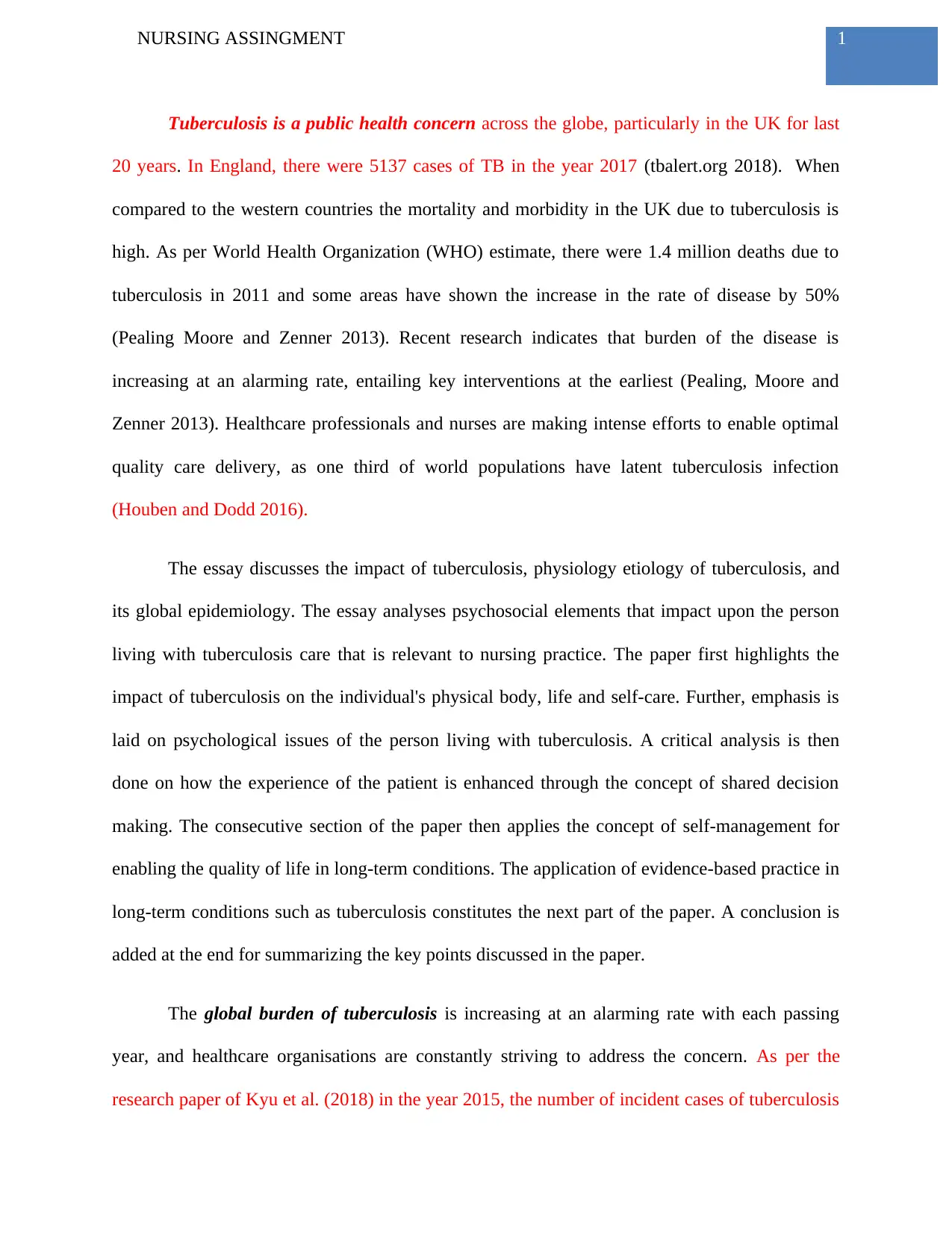
1NURSING ASSINGMENT
Tuberculosis is a public health concern across the globe, particularly in the UK for last
20 years. In England, there were 5137 cases of TB in the year 2017 (tbalert.org 2018). When
compared to the western countries the mortality and morbidity in the UK due to tuberculosis is
high. As per World Health Organization (WHO) estimate, there were 1.4 million deaths due to
tuberculosis in 2011 and some areas have shown the increase in the rate of disease by 50%
(Pealing Moore and Zenner 2013). Recent research indicates that burden of the disease is
increasing at an alarming rate, entailing key interventions at the earliest (Pealing, Moore and
Zenner 2013). Healthcare professionals and nurses are making intense efforts to enable optimal
quality care delivery, as one third of world populations have latent tuberculosis infection
(Houben and Dodd 2016).
The essay discusses the impact of tuberculosis, physiology etiology of tuberculosis, and
its global epidemiology. The essay analyses psychosocial elements that impact upon the person
living with tuberculosis care that is relevant to nursing practice. The paper first highlights the
impact of tuberculosis on the individual's physical body, life and self-care. Further, emphasis is
laid on psychological issues of the person living with tuberculosis. A critical analysis is then
done on how the experience of the patient is enhanced through the concept of shared decision
making. The consecutive section of the paper then applies the concept of self-management for
enabling the quality of life in long-term conditions. The application of evidence-based practice in
long-term conditions such as tuberculosis constitutes the next part of the paper. A conclusion is
added at the end for summarizing the key points discussed in the paper.
The global burden of tuberculosis is increasing at an alarming rate with each passing
year, and healthcare organisations are constantly striving to address the concern. As per the
research paper of Kyu et al. (2018) in the year 2015, the number of incident cases of tuberculosis
Tuberculosis is a public health concern across the globe, particularly in the UK for last
20 years. In England, there were 5137 cases of TB in the year 2017 (tbalert.org 2018). When
compared to the western countries the mortality and morbidity in the UK due to tuberculosis is
high. As per World Health Organization (WHO) estimate, there were 1.4 million deaths due to
tuberculosis in 2011 and some areas have shown the increase in the rate of disease by 50%
(Pealing Moore and Zenner 2013). Recent research indicates that burden of the disease is
increasing at an alarming rate, entailing key interventions at the earliest (Pealing, Moore and
Zenner 2013). Healthcare professionals and nurses are making intense efforts to enable optimal
quality care delivery, as one third of world populations have latent tuberculosis infection
(Houben and Dodd 2016).
The essay discusses the impact of tuberculosis, physiology etiology of tuberculosis, and
its global epidemiology. The essay analyses psychosocial elements that impact upon the person
living with tuberculosis care that is relevant to nursing practice. The paper first highlights the
impact of tuberculosis on the individual's physical body, life and self-care. Further, emphasis is
laid on psychological issues of the person living with tuberculosis. A critical analysis is then
done on how the experience of the patient is enhanced through the concept of shared decision
making. The consecutive section of the paper then applies the concept of self-management for
enabling the quality of life in long-term conditions. The application of evidence-based practice in
long-term conditions such as tuberculosis constitutes the next part of the paper. A conclusion is
added at the end for summarizing the key points discussed in the paper.
The global burden of tuberculosis is increasing at an alarming rate with each passing
year, and healthcare organisations are constantly striving to address the concern. As per the
research paper of Kyu et al. (2018) in the year 2015, the number of incident cases of tuberculosis
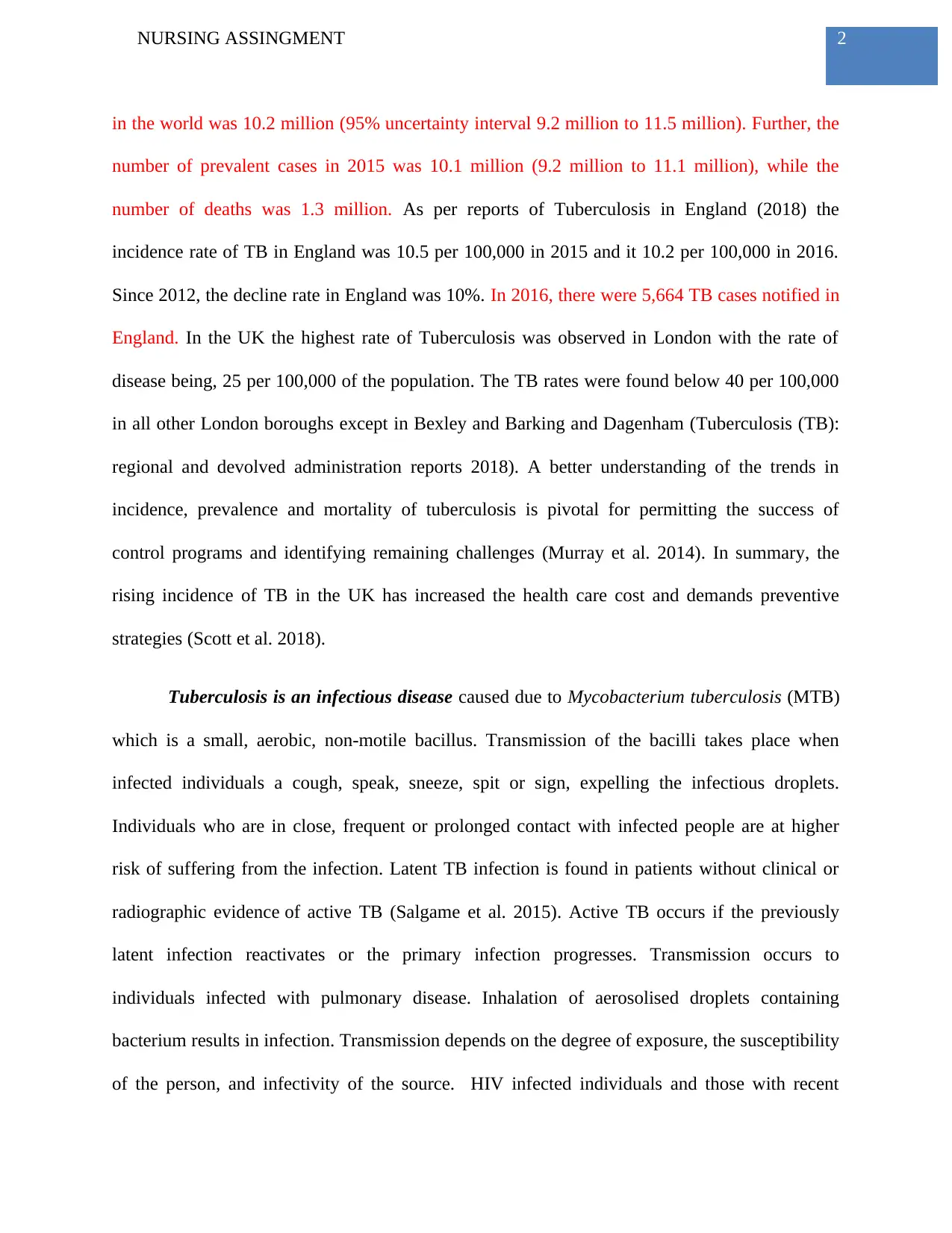
2NURSING ASSINGMENT
in the world was 10.2 million (95% uncertainty interval 9.2 million to 11.5 million). Further, the
number of prevalent cases in 2015 was 10.1 million (9.2 million to 11.1 million), while the
number of deaths was 1.3 million. As per reports of Tuberculosis in England (2018) the
incidence rate of TB in England was 10.5 per 100,000 in 2015 and it 10.2 per 100,000 in 2016.
Since 2012, the decline rate in England was 10%. In 2016, there were 5,664 TB cases notified in
England. In the UK the highest rate of Tuberculosis was observed in London with the rate of
disease being, 25 per 100,000 of the population. The TB rates were found below 40 per 100,000
in all other London boroughs except in Bexley and Barking and Dagenham (Tuberculosis (TB):
regional and devolved administration reports 2018). A better understanding of the trends in
incidence, prevalence and mortality of tuberculosis is pivotal for permitting the success of
control programs and identifying remaining challenges (Murray et al. 2014). In summary, the
rising incidence of TB in the UK has increased the health care cost and demands preventive
strategies (Scott et al. 2018).
Tuberculosis is an infectious disease caused due to Mycobacterium tuberculosis (MTB)
which is a small, aerobic, non-motile bacillus. Transmission of the bacilli takes place when
infected individuals a cough, speak, sneeze, spit or sign, expelling the infectious droplets.
Individuals who are in close, frequent or prolonged contact with infected people are at higher
risk of suffering from the infection. Latent TB infection is found in patients without clinical or
radiographic evidence of active TB (Salgame et al. 2015). Active TB occurs if the previously
latent infection reactivates or the primary infection progresses. Transmission occurs to
individuals infected with pulmonary disease. Inhalation of aerosolised droplets containing
bacterium results in infection. Transmission depends on the degree of exposure, the susceptibility
of the person, and infectivity of the source. HIV infected individuals and those with recent
in the world was 10.2 million (95% uncertainty interval 9.2 million to 11.5 million). Further, the
number of prevalent cases in 2015 was 10.1 million (9.2 million to 11.1 million), while the
number of deaths was 1.3 million. As per reports of Tuberculosis in England (2018) the
incidence rate of TB in England was 10.5 per 100,000 in 2015 and it 10.2 per 100,000 in 2016.
Since 2012, the decline rate in England was 10%. In 2016, there were 5,664 TB cases notified in
England. In the UK the highest rate of Tuberculosis was observed in London with the rate of
disease being, 25 per 100,000 of the population. The TB rates were found below 40 per 100,000
in all other London boroughs except in Bexley and Barking and Dagenham (Tuberculosis (TB):
regional and devolved administration reports 2018). A better understanding of the trends in
incidence, prevalence and mortality of tuberculosis is pivotal for permitting the success of
control programs and identifying remaining challenges (Murray et al. 2014). In summary, the
rising incidence of TB in the UK has increased the health care cost and demands preventive
strategies (Scott et al. 2018).
Tuberculosis is an infectious disease caused due to Mycobacterium tuberculosis (MTB)
which is a small, aerobic, non-motile bacillus. Transmission of the bacilli takes place when
infected individuals a cough, speak, sneeze, spit or sign, expelling the infectious droplets.
Individuals who are in close, frequent or prolonged contact with infected people are at higher
risk of suffering from the infection. Latent TB infection is found in patients without clinical or
radiographic evidence of active TB (Salgame et al. 2015). Active TB occurs if the previously
latent infection reactivates or the primary infection progresses. Transmission occurs to
individuals infected with pulmonary disease. Inhalation of aerosolised droplets containing
bacterium results in infection. Transmission depends on the degree of exposure, the susceptibility
of the person, and infectivity of the source. HIV infected individuals and those with recent
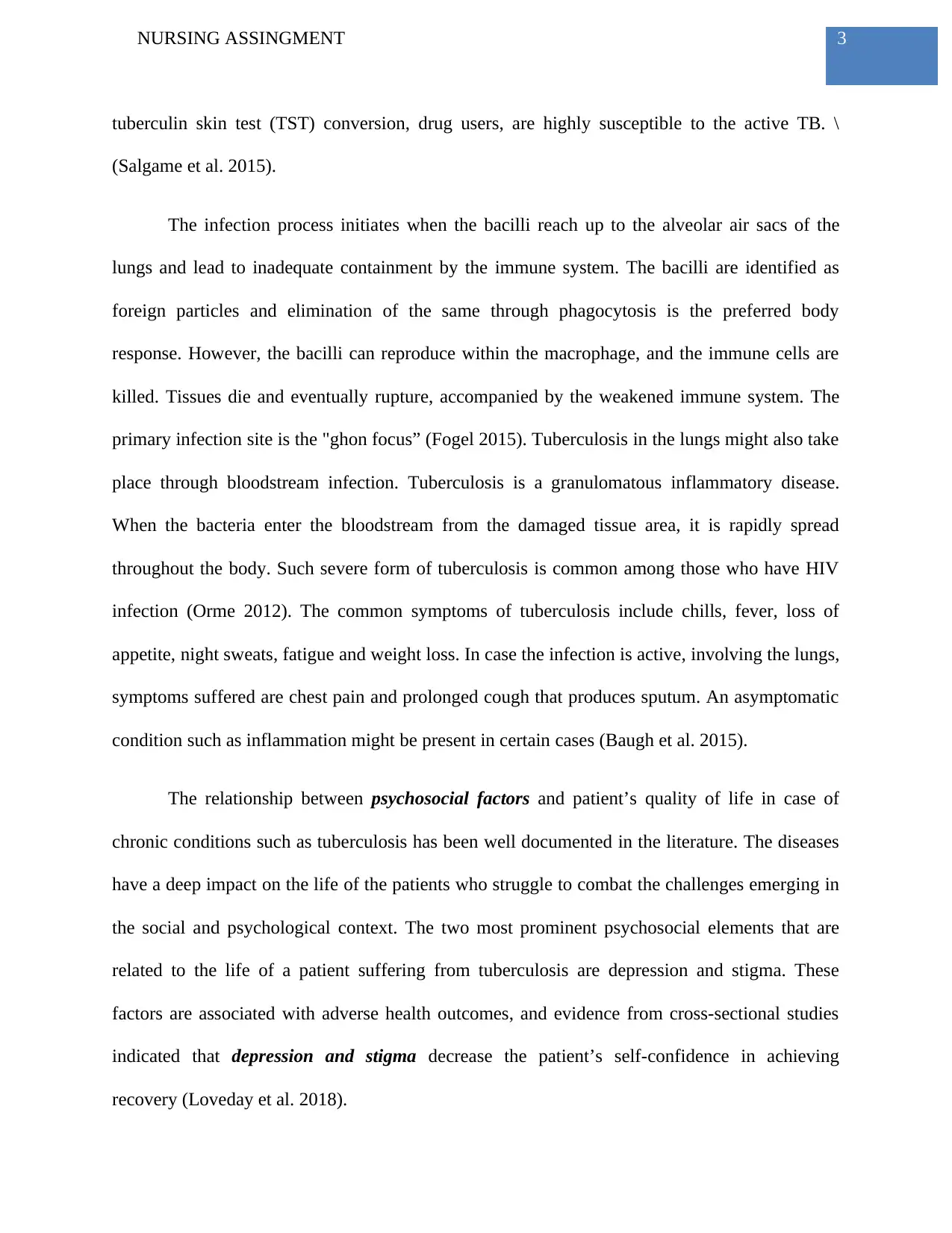
3NURSING ASSINGMENT
tuberculin skin test (TST) conversion, drug users, are highly susceptible to the active TB. \
(Salgame et al. 2015).
The infection process initiates when the bacilli reach up to the alveolar air sacs of the
lungs and lead to inadequate containment by the immune system. The bacilli are identified as
foreign particles and elimination of the same through phagocytosis is the preferred body
response. However, the bacilli can reproduce within the macrophage, and the immune cells are
killed. Tissues die and eventually rupture, accompanied by the weakened immune system. The
primary infection site is the "ghon focus” (Fogel 2015). Tuberculosis in the lungs might also take
place through bloodstream infection. Tuberculosis is a granulomatous inflammatory disease.
When the bacteria enter the bloodstream from the damaged tissue area, it is rapidly spread
throughout the body. Such severe form of tuberculosis is common among those who have HIV
infection (Orme 2012). The common symptoms of tuberculosis include chills, fever, loss of
appetite, night sweats, fatigue and weight loss. In case the infection is active, involving the lungs,
symptoms suffered are chest pain and prolonged cough that produces sputum. An asymptomatic
condition such as inflammation might be present in certain cases (Baugh et al. 2015).
The relationship between psychosocial factors and patient’s quality of life in case of
chronic conditions such as tuberculosis has been well documented in the literature. The diseases
have a deep impact on the life of the patients who struggle to combat the challenges emerging in
the social and psychological context. The two most prominent psychosocial elements that are
related to the life of a patient suffering from tuberculosis are depression and stigma. These
factors are associated with adverse health outcomes, and evidence from cross-sectional studies
indicated that depression and stigma decrease the patient’s self-confidence in achieving
recovery (Loveday et al. 2018).
tuberculin skin test (TST) conversion, drug users, are highly susceptible to the active TB. \
(Salgame et al. 2015).
The infection process initiates when the bacilli reach up to the alveolar air sacs of the
lungs and lead to inadequate containment by the immune system. The bacilli are identified as
foreign particles and elimination of the same through phagocytosis is the preferred body
response. However, the bacilli can reproduce within the macrophage, and the immune cells are
killed. Tissues die and eventually rupture, accompanied by the weakened immune system. The
primary infection site is the "ghon focus” (Fogel 2015). Tuberculosis in the lungs might also take
place through bloodstream infection. Tuberculosis is a granulomatous inflammatory disease.
When the bacteria enter the bloodstream from the damaged tissue area, it is rapidly spread
throughout the body. Such severe form of tuberculosis is common among those who have HIV
infection (Orme 2012). The common symptoms of tuberculosis include chills, fever, loss of
appetite, night sweats, fatigue and weight loss. In case the infection is active, involving the lungs,
symptoms suffered are chest pain and prolonged cough that produces sputum. An asymptomatic
condition such as inflammation might be present in certain cases (Baugh et al. 2015).
The relationship between psychosocial factors and patient’s quality of life in case of
chronic conditions such as tuberculosis has been well documented in the literature. The diseases
have a deep impact on the life of the patients who struggle to combat the challenges emerging in
the social and psychological context. The two most prominent psychosocial elements that are
related to the life of a patient suffering from tuberculosis are depression and stigma. These
factors are associated with adverse health outcomes, and evidence from cross-sectional studies
indicated that depression and stigma decrease the patient’s self-confidence in achieving
recovery (Loveday et al. 2018).
Secure Best Marks with AI Grader
Need help grading? Try our AI Grader for instant feedback on your assignments.
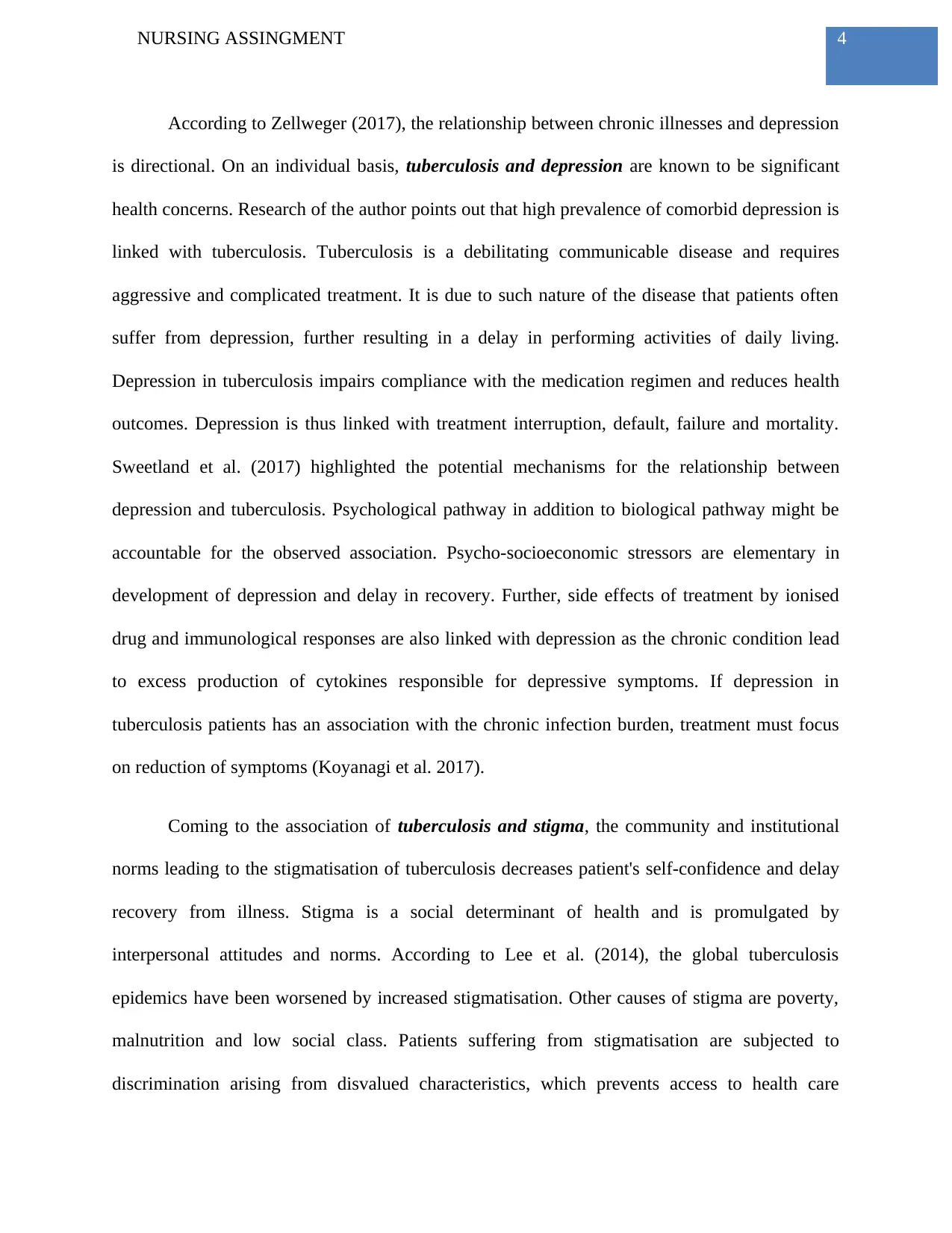
4NURSING ASSINGMENT
According to Zellweger (2017), the relationship between chronic illnesses and depression
is directional. On an individual basis, tuberculosis and depression are known to be significant
health concerns. Research of the author points out that high prevalence of comorbid depression is
linked with tuberculosis. Tuberculosis is a debilitating communicable disease and requires
aggressive and complicated treatment. It is due to such nature of the disease that patients often
suffer from depression, further resulting in a delay in performing activities of daily living.
Depression in tuberculosis impairs compliance with the medication regimen and reduces health
outcomes. Depression is thus linked with treatment interruption, default, failure and mortality.
Sweetland et al. (2017) highlighted the potential mechanisms for the relationship between
depression and tuberculosis. Psychological pathway in addition to biological pathway might be
accountable for the observed association. Psycho-socioeconomic stressors are elementary in
development of depression and delay in recovery. Further, side effects of treatment by ionised
drug and immunological responses are also linked with depression as the chronic condition lead
to excess production of cytokines responsible for depressive symptoms. If depression in
tuberculosis patients has an association with the chronic infection burden, treatment must focus
on reduction of symptoms (Koyanagi et al. 2017).
Coming to the association of tuberculosis and stigma, the community and institutional
norms leading to the stigmatisation of tuberculosis decreases patient's self-confidence and delay
recovery from illness. Stigma is a social determinant of health and is promulgated by
interpersonal attitudes and norms. According to Lee et al. (2014), the global tuberculosis
epidemics have been worsened by increased stigmatisation. Other causes of stigma are poverty,
malnutrition and low social class. Patients suffering from stigmatisation are subjected to
discrimination arising from disvalued characteristics, which prevents access to health care
According to Zellweger (2017), the relationship between chronic illnesses and depression
is directional. On an individual basis, tuberculosis and depression are known to be significant
health concerns. Research of the author points out that high prevalence of comorbid depression is
linked with tuberculosis. Tuberculosis is a debilitating communicable disease and requires
aggressive and complicated treatment. It is due to such nature of the disease that patients often
suffer from depression, further resulting in a delay in performing activities of daily living.
Depression in tuberculosis impairs compliance with the medication regimen and reduces health
outcomes. Depression is thus linked with treatment interruption, default, failure and mortality.
Sweetland et al. (2017) highlighted the potential mechanisms for the relationship between
depression and tuberculosis. Psychological pathway in addition to biological pathway might be
accountable for the observed association. Psycho-socioeconomic stressors are elementary in
development of depression and delay in recovery. Further, side effects of treatment by ionised
drug and immunological responses are also linked with depression as the chronic condition lead
to excess production of cytokines responsible for depressive symptoms. If depression in
tuberculosis patients has an association with the chronic infection burden, treatment must focus
on reduction of symptoms (Koyanagi et al. 2017).
Coming to the association of tuberculosis and stigma, the community and institutional
norms leading to the stigmatisation of tuberculosis decreases patient's self-confidence and delay
recovery from illness. Stigma is a social determinant of health and is promulgated by
interpersonal attitudes and norms. According to Lee et al. (2014), the global tuberculosis
epidemics have been worsened by increased stigmatisation. Other causes of stigma are poverty,
malnutrition and low social class. Patients suffering from stigmatisation are subjected to
discrimination arising from disvalued characteristics, which prevents access to health care
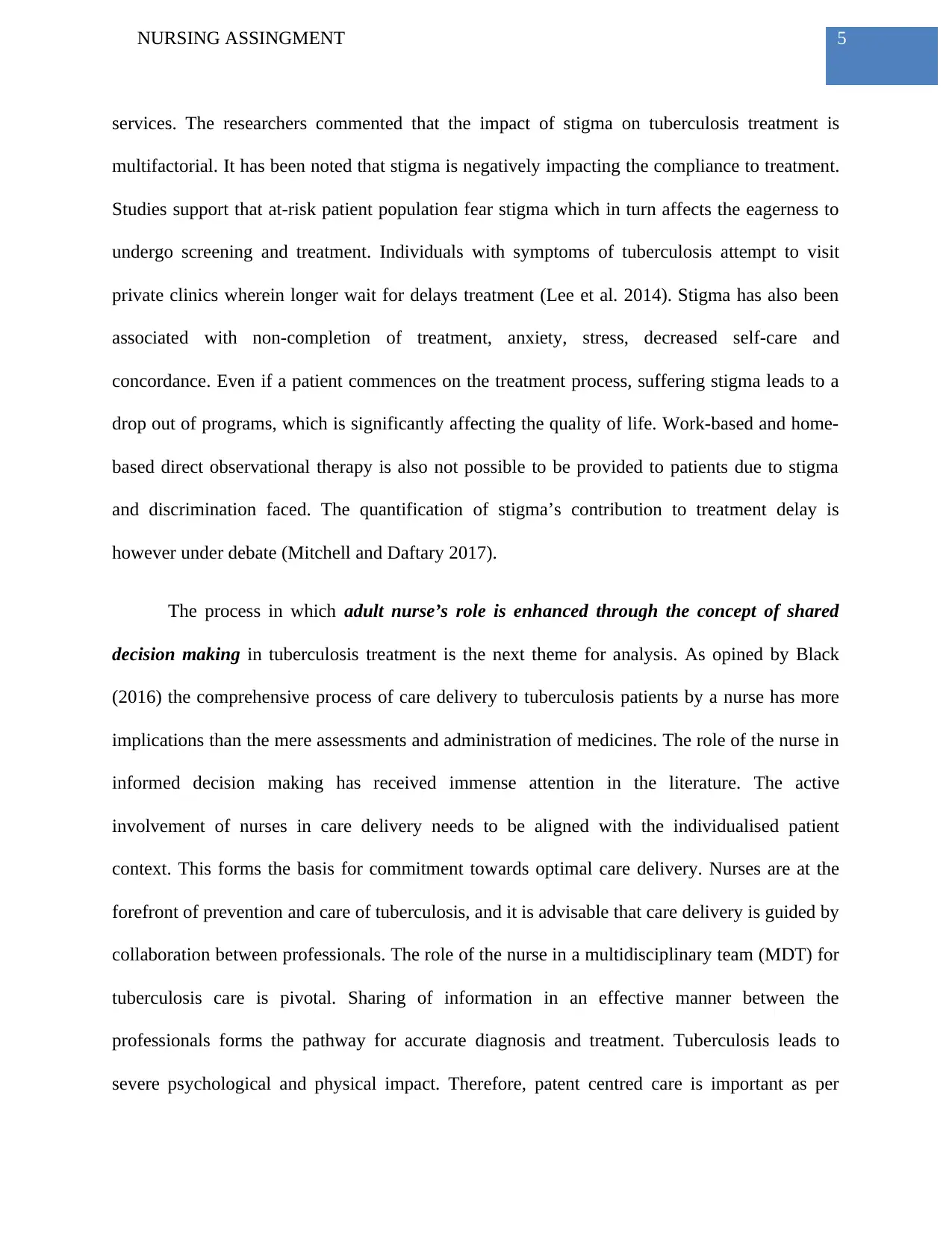
5NURSING ASSINGMENT
services. The researchers commented that the impact of stigma on tuberculosis treatment is
multifactorial. It has been noted that stigma is negatively impacting the compliance to treatment.
Studies support that at-risk patient population fear stigma which in turn affects the eagerness to
undergo screening and treatment. Individuals with symptoms of tuberculosis attempt to visit
private clinics wherein longer wait for delays treatment (Lee et al. 2014). Stigma has also been
associated with non-completion of treatment, anxiety, stress, decreased self-care and
concordance. Even if a patient commences on the treatment process, suffering stigma leads to a
drop out of programs, which is significantly affecting the quality of life. Work-based and home-
based direct observational therapy is also not possible to be provided to patients due to stigma
and discrimination faced. The quantification of stigma’s contribution to treatment delay is
however under debate (Mitchell and Daftary 2017).
The process in which adult nurse’s role is enhanced through the concept of shared
decision making in tuberculosis treatment is the next theme for analysis. As opined by Black
(2016) the comprehensive process of care delivery to tuberculosis patients by a nurse has more
implications than the mere assessments and administration of medicines. The role of the nurse in
informed decision making has received immense attention in the literature. The active
involvement of nurses in care delivery needs to be aligned with the individualised patient
context. This forms the basis for commitment towards optimal care delivery. Nurses are at the
forefront of prevention and care of tuberculosis, and it is advisable that care delivery is guided by
collaboration between professionals. The role of the nurse in a multidisciplinary team (MDT) for
tuberculosis care is pivotal. Sharing of information in an effective manner between the
professionals forms the pathway for accurate diagnosis and treatment. Tuberculosis leads to
severe psychological and physical impact. Therefore, patent centred care is important as per
services. The researchers commented that the impact of stigma on tuberculosis treatment is
multifactorial. It has been noted that stigma is negatively impacting the compliance to treatment.
Studies support that at-risk patient population fear stigma which in turn affects the eagerness to
undergo screening and treatment. Individuals with symptoms of tuberculosis attempt to visit
private clinics wherein longer wait for delays treatment (Lee et al. 2014). Stigma has also been
associated with non-completion of treatment, anxiety, stress, decreased self-care and
concordance. Even if a patient commences on the treatment process, suffering stigma leads to a
drop out of programs, which is significantly affecting the quality of life. Work-based and home-
based direct observational therapy is also not possible to be provided to patients due to stigma
and discrimination faced. The quantification of stigma’s contribution to treatment delay is
however under debate (Mitchell and Daftary 2017).
The process in which adult nurse’s role is enhanced through the concept of shared
decision making in tuberculosis treatment is the next theme for analysis. As opined by Black
(2016) the comprehensive process of care delivery to tuberculosis patients by a nurse has more
implications than the mere assessments and administration of medicines. The role of the nurse in
informed decision making has received immense attention in the literature. The active
involvement of nurses in care delivery needs to be aligned with the individualised patient
context. This forms the basis for commitment towards optimal care delivery. Nurses are at the
forefront of prevention and care of tuberculosis, and it is advisable that care delivery is guided by
collaboration between professionals. The role of the nurse in a multidisciplinary team (MDT) for
tuberculosis care is pivotal. Sharing of information in an effective manner between the
professionals forms the pathway for accurate diagnosis and treatment. Tuberculosis leads to
severe psychological and physical impact. Therefore, patent centred care is important as per
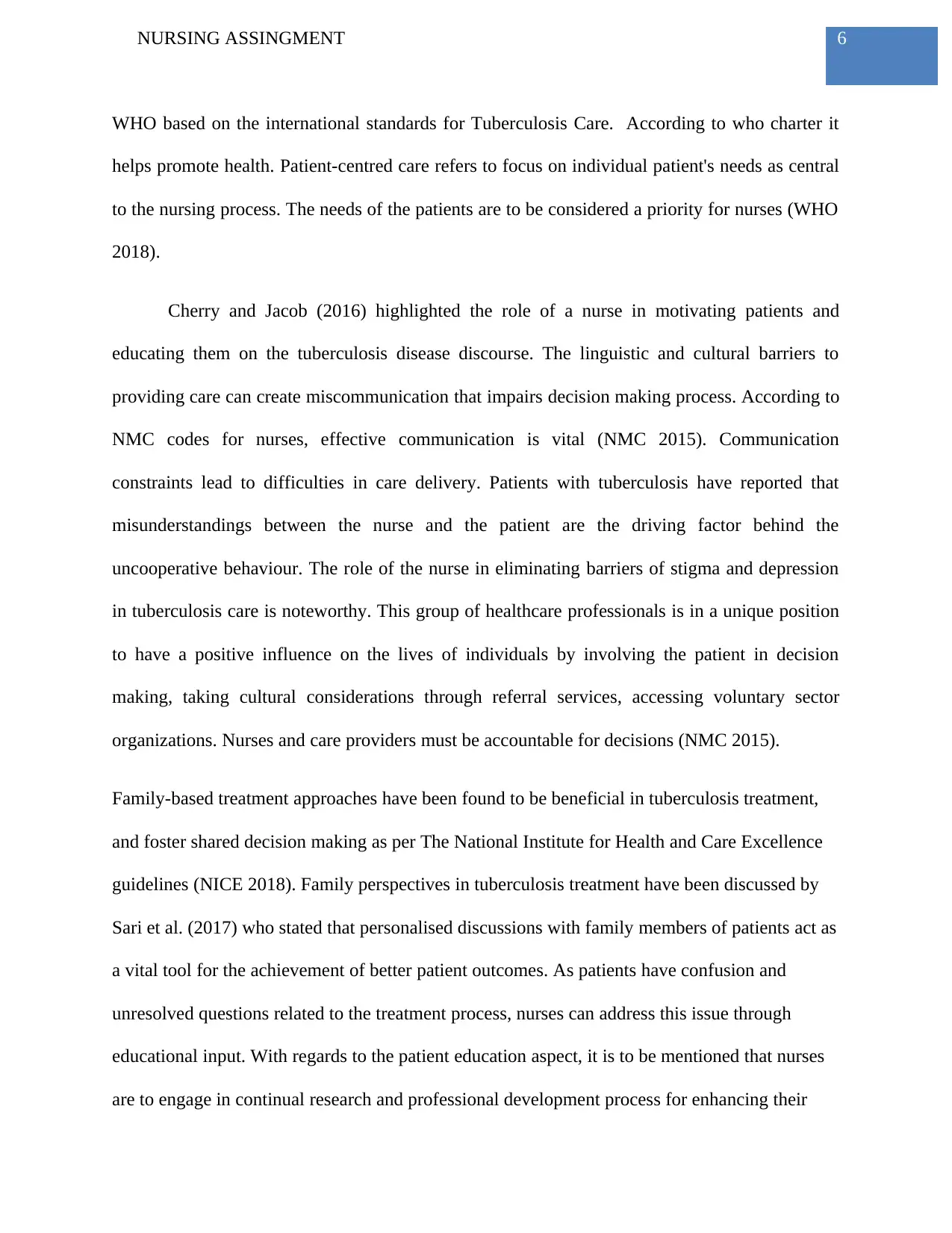
6NURSING ASSINGMENT
WHO based on the international standards for Tuberculosis Care. According to who charter it
helps promote health. Patient-centred care refers to focus on individual patient's needs as central
to the nursing process. The needs of the patients are to be considered a priority for nurses (WHO
2018).
Cherry and Jacob (2016) highlighted the role of a nurse in motivating patients and
educating them on the tuberculosis disease discourse. The linguistic and cultural barriers to
providing care can create miscommunication that impairs decision making process. According to
NMC codes for nurses, effective communication is vital (NMC 2015). Communication
constraints lead to difficulties in care delivery. Patients with tuberculosis have reported that
misunderstandings between the nurse and the patient are the driving factor behind the
uncooperative behaviour. The role of the nurse in eliminating barriers of stigma and depression
in tuberculosis care is noteworthy. This group of healthcare professionals is in a unique position
to have a positive influence on the lives of individuals by involving the patient in decision
making, taking cultural considerations through referral services, accessing voluntary sector
organizations. Nurses and care providers must be accountable for decisions (NMC 2015).
Family-based treatment approaches have been found to be beneficial in tuberculosis treatment,
and foster shared decision making as per The National Institute for Health and Care Excellence
guidelines (NICE 2018). Family perspectives in tuberculosis treatment have been discussed by
Sari et al. (2017) who stated that personalised discussions with family members of patients act as
a vital tool for the achievement of better patient outcomes. As patients have confusion and
unresolved questions related to the treatment process, nurses can address this issue through
educational input. With regards to the patient education aspect, it is to be mentioned that nurses
are to engage in continual research and professional development process for enhancing their
WHO based on the international standards for Tuberculosis Care. According to who charter it
helps promote health. Patient-centred care refers to focus on individual patient's needs as central
to the nursing process. The needs of the patients are to be considered a priority for nurses (WHO
2018).
Cherry and Jacob (2016) highlighted the role of a nurse in motivating patients and
educating them on the tuberculosis disease discourse. The linguistic and cultural barriers to
providing care can create miscommunication that impairs decision making process. According to
NMC codes for nurses, effective communication is vital (NMC 2015). Communication
constraints lead to difficulties in care delivery. Patients with tuberculosis have reported that
misunderstandings between the nurse and the patient are the driving factor behind the
uncooperative behaviour. The role of the nurse in eliminating barriers of stigma and depression
in tuberculosis care is noteworthy. This group of healthcare professionals is in a unique position
to have a positive influence on the lives of individuals by involving the patient in decision
making, taking cultural considerations through referral services, accessing voluntary sector
organizations. Nurses and care providers must be accountable for decisions (NMC 2015).
Family-based treatment approaches have been found to be beneficial in tuberculosis treatment,
and foster shared decision making as per The National Institute for Health and Care Excellence
guidelines (NICE 2018). Family perspectives in tuberculosis treatment have been discussed by
Sari et al. (2017) who stated that personalised discussions with family members of patients act as
a vital tool for the achievement of better patient outcomes. As patients have confusion and
unresolved questions related to the treatment process, nurses can address this issue through
educational input. With regards to the patient education aspect, it is to be mentioned that nurses
are to engage in continual research and professional development process for enhancing their
Paraphrase This Document
Need a fresh take? Get an instant paraphrase of this document with our AI Paraphraser
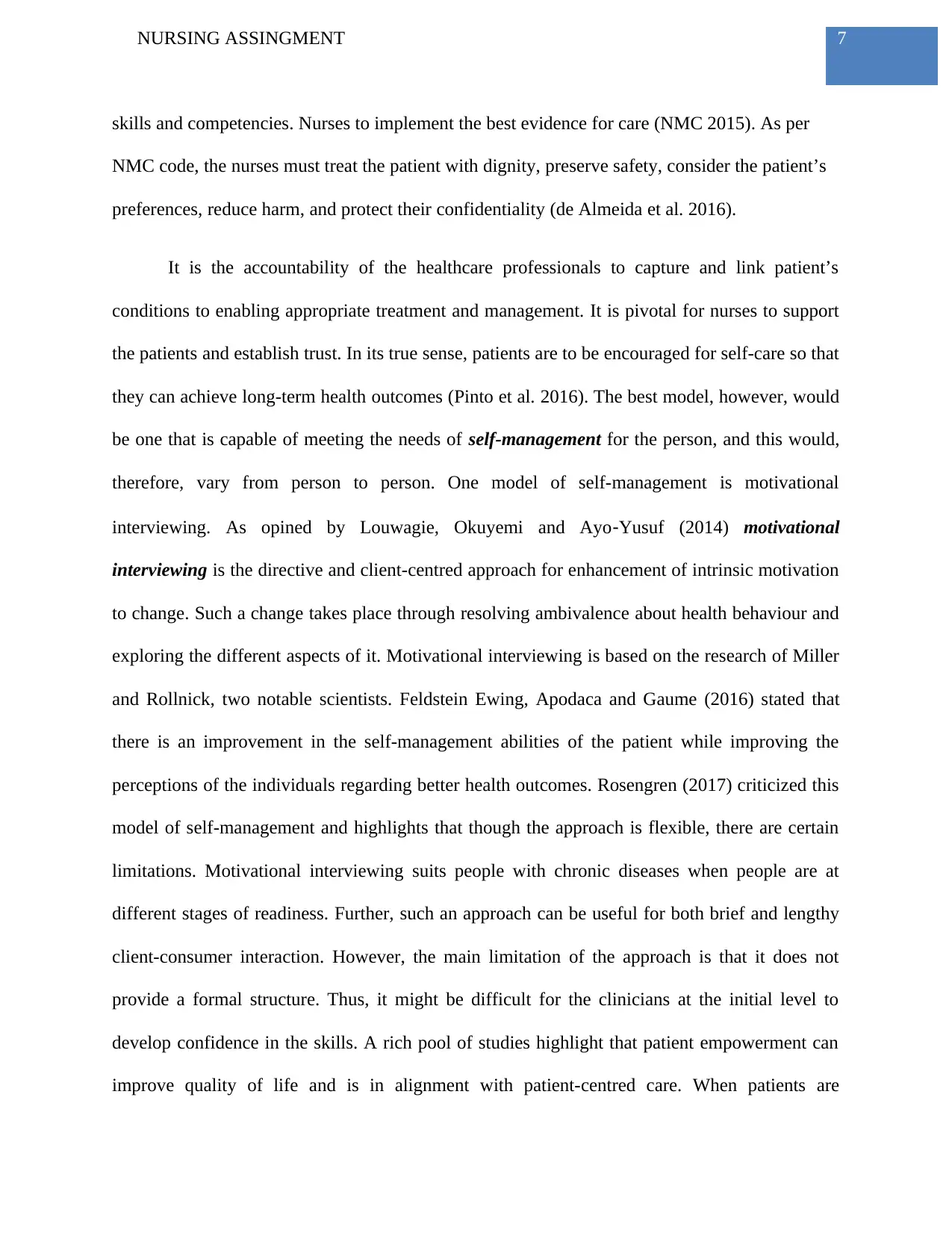
7NURSING ASSINGMENT
skills and competencies. Nurses to implement the best evidence for care (NMC 2015). As per
NMC code, the nurses must treat the patient with dignity, preserve safety, consider the patient’s
preferences, reduce harm, and protect their confidentiality (de Almeida et al. 2016).
It is the accountability of the healthcare professionals to capture and link patient’s
conditions to enabling appropriate treatment and management. It is pivotal for nurses to support
the patients and establish trust. In its true sense, patients are to be encouraged for self-care so that
they can achieve long-term health outcomes (Pinto et al. 2016). The best model, however, would
be one that is capable of meeting the needs of self-management for the person, and this would,
therefore, vary from person to person. One model of self-management is motivational
interviewing. As opined by Louwagie, Okuyemi and Ayo‐Yusuf (2014) motivational
interviewing is the directive and client-centred approach for enhancement of intrinsic motivation
to change. Such a change takes place through resolving ambivalence about health behaviour and
exploring the different aspects of it. Motivational interviewing is based on the research of Miller
and Rollnick, two notable scientists. Feldstein Ewing, Apodaca and Gaume (2016) stated that
there is an improvement in the self-management abilities of the patient while improving the
perceptions of the individuals regarding better health outcomes. Rosengren (2017) criticized this
model of self-management and highlights that though the approach is flexible, there are certain
limitations. Motivational interviewing suits people with chronic diseases when people are at
different stages of readiness. Further, such an approach can be useful for both brief and lengthy
client-consumer interaction. However, the main limitation of the approach is that it does not
provide a formal structure. Thus, it might be difficult for the clinicians at the initial level to
develop confidence in the skills. A rich pool of studies highlight that patient empowerment can
improve quality of life and is in alignment with patient-centred care. When patients are
skills and competencies. Nurses to implement the best evidence for care (NMC 2015). As per
NMC code, the nurses must treat the patient with dignity, preserve safety, consider the patient’s
preferences, reduce harm, and protect their confidentiality (de Almeida et al. 2016).
It is the accountability of the healthcare professionals to capture and link patient’s
conditions to enabling appropriate treatment and management. It is pivotal for nurses to support
the patients and establish trust. In its true sense, patients are to be encouraged for self-care so that
they can achieve long-term health outcomes (Pinto et al. 2016). The best model, however, would
be one that is capable of meeting the needs of self-management for the person, and this would,
therefore, vary from person to person. One model of self-management is motivational
interviewing. As opined by Louwagie, Okuyemi and Ayo‐Yusuf (2014) motivational
interviewing is the directive and client-centred approach for enhancement of intrinsic motivation
to change. Such a change takes place through resolving ambivalence about health behaviour and
exploring the different aspects of it. Motivational interviewing is based on the research of Miller
and Rollnick, two notable scientists. Feldstein Ewing, Apodaca and Gaume (2016) stated that
there is an improvement in the self-management abilities of the patient while improving the
perceptions of the individuals regarding better health outcomes. Rosengren (2017) criticized this
model of self-management and highlights that though the approach is flexible, there are certain
limitations. Motivational interviewing suits people with chronic diseases when people are at
different stages of readiness. Further, such an approach can be useful for both brief and lengthy
client-consumer interaction. However, the main limitation of the approach is that it does not
provide a formal structure. Thus, it might be difficult for the clinicians at the initial level to
develop confidence in the skills. A rich pool of studies highlight that patient empowerment can
improve quality of life and is in alignment with patient-centred care. When patients are
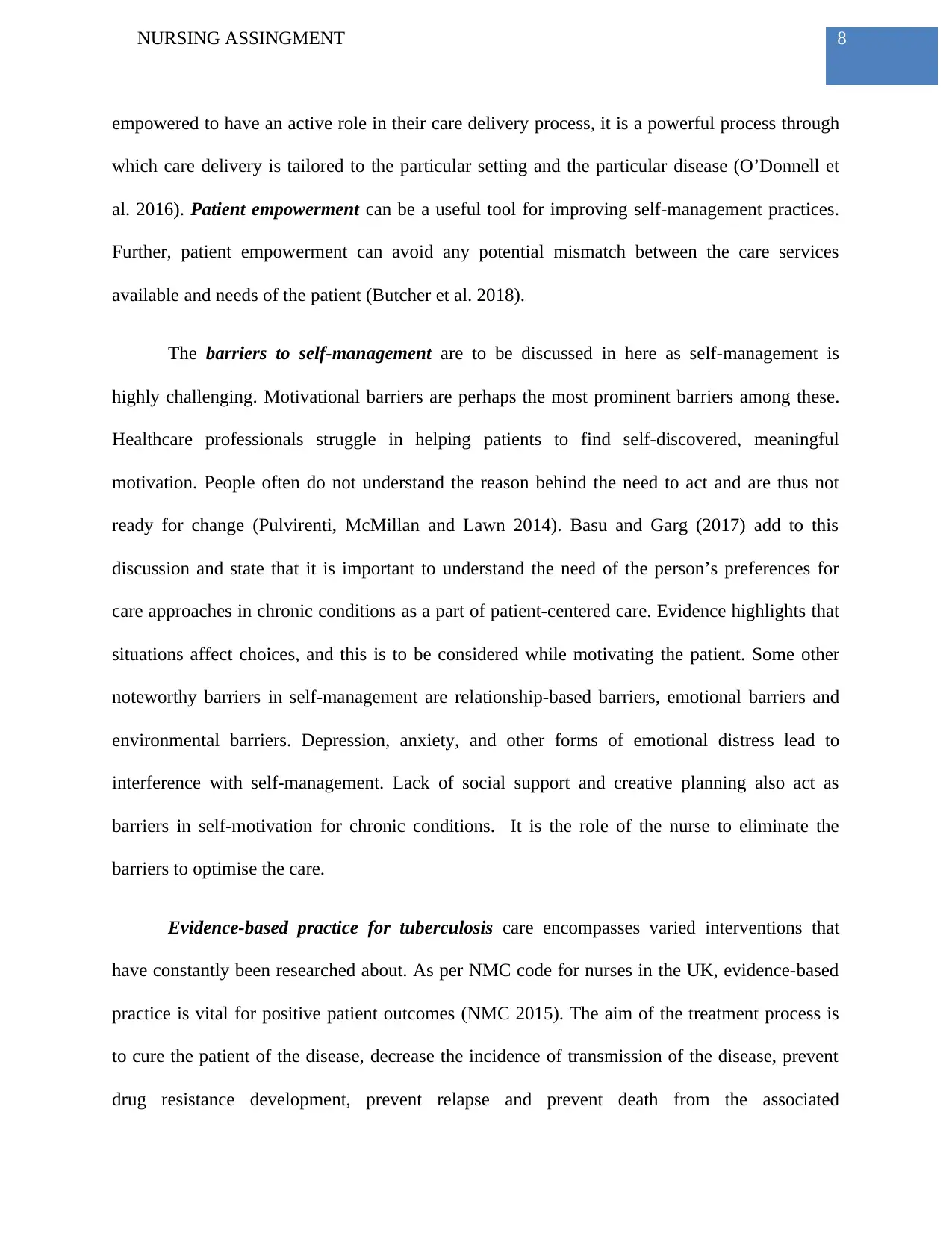
8NURSING ASSINGMENT
empowered to have an active role in their care delivery process, it is a powerful process through
which care delivery is tailored to the particular setting and the particular disease (O’Donnell et
al. 2016). Patient empowerment can be a useful tool for improving self-management practices.
Further, patient empowerment can avoid any potential mismatch between the care services
available and needs of the patient (Butcher et al. 2018).
The barriers to self-management are to be discussed in here as self-management is
highly challenging. Motivational barriers are perhaps the most prominent barriers among these.
Healthcare professionals struggle in helping patients to find self-discovered, meaningful
motivation. People often do not understand the reason behind the need to act and are thus not
ready for change (Pulvirenti, McMillan and Lawn 2014). Basu and Garg (2017) add to this
discussion and state that it is important to understand the need of the person’s preferences for
care approaches in chronic conditions as a part of patient-centered care. Evidence highlights that
situations affect choices, and this is to be considered while motivating the patient. Some other
noteworthy barriers in self-management are relationship-based barriers, emotional barriers and
environmental barriers. Depression, anxiety, and other forms of emotional distress lead to
interference with self-management. Lack of social support and creative planning also act as
barriers in self-motivation for chronic conditions. It is the role of the nurse to eliminate the
barriers to optimise the care.
Evidence-based practice for tuberculosis care encompasses varied interventions that
have constantly been researched about. As per NMC code for nurses in the UK, evidence-based
practice is vital for positive patient outcomes (NMC 2015). The aim of the treatment process is
to cure the patient of the disease, decrease the incidence of transmission of the disease, prevent
drug resistance development, prevent relapse and prevent death from the associated
empowered to have an active role in their care delivery process, it is a powerful process through
which care delivery is tailored to the particular setting and the particular disease (O’Donnell et
al. 2016). Patient empowerment can be a useful tool for improving self-management practices.
Further, patient empowerment can avoid any potential mismatch between the care services
available and needs of the patient (Butcher et al. 2018).
The barriers to self-management are to be discussed in here as self-management is
highly challenging. Motivational barriers are perhaps the most prominent barriers among these.
Healthcare professionals struggle in helping patients to find self-discovered, meaningful
motivation. People often do not understand the reason behind the need to act and are thus not
ready for change (Pulvirenti, McMillan and Lawn 2014). Basu and Garg (2017) add to this
discussion and state that it is important to understand the need of the person’s preferences for
care approaches in chronic conditions as a part of patient-centered care. Evidence highlights that
situations affect choices, and this is to be considered while motivating the patient. Some other
noteworthy barriers in self-management are relationship-based barriers, emotional barriers and
environmental barriers. Depression, anxiety, and other forms of emotional distress lead to
interference with self-management. Lack of social support and creative planning also act as
barriers in self-motivation for chronic conditions. It is the role of the nurse to eliminate the
barriers to optimise the care.
Evidence-based practice for tuberculosis care encompasses varied interventions that
have constantly been researched about. As per NMC code for nurses in the UK, evidence-based
practice is vital for positive patient outcomes (NMC 2015). The aim of the treatment process is
to cure the patient of the disease, decrease the incidence of transmission of the disease, prevent
drug resistance development, prevent relapse and prevent death from the associated
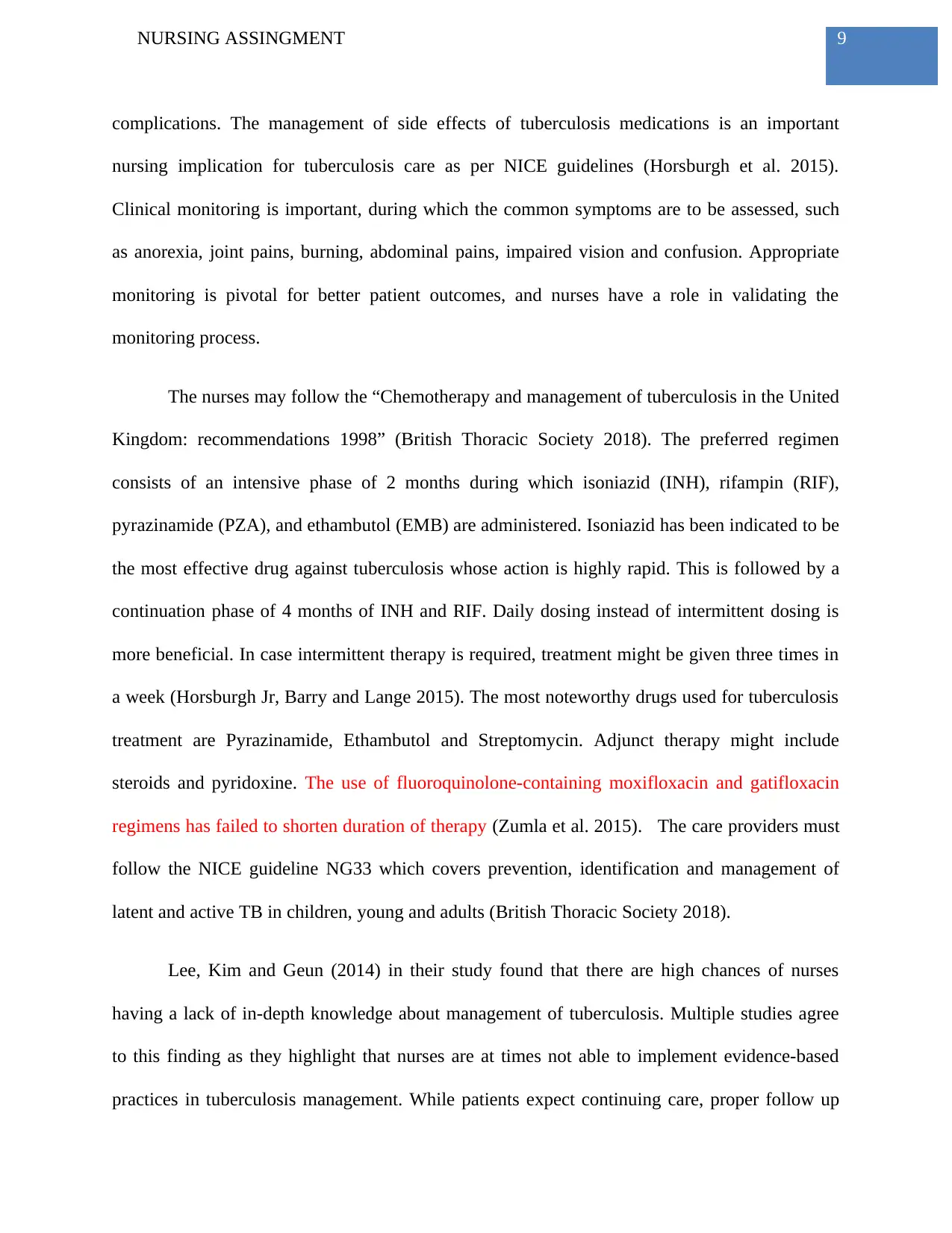
9NURSING ASSINGMENT
complications. The management of side effects of tuberculosis medications is an important
nursing implication for tuberculosis care as per NICE guidelines (Horsburgh et al. 2015).
Clinical monitoring is important, during which the common symptoms are to be assessed, such
as anorexia, joint pains, burning, abdominal pains, impaired vision and confusion. Appropriate
monitoring is pivotal for better patient outcomes, and nurses have a role in validating the
monitoring process.
The nurses may follow the “Chemotherapy and management of tuberculosis in the United
Kingdom: recommendations 1998” (British Thoracic Society 2018). The preferred regimen
consists of an intensive phase of 2 months during which isoniazid (INH), rifampin (RIF),
pyrazinamide (PZA), and ethambutol (EMB) are administered. Isoniazid has been indicated to be
the most effective drug against tuberculosis whose action is highly rapid. This is followed by a
continuation phase of 4 months of INH and RIF. Daily dosing instead of intermittent dosing is
more beneficial. In case intermittent therapy is required, treatment might be given three times in
a week (Horsburgh Jr, Barry and Lange 2015). The most noteworthy drugs used for tuberculosis
treatment are Pyrazinamide, Ethambutol and Streptomycin. Adjunct therapy might include
steroids and pyridoxine. The use of fluoroquinolone-containing moxifloxacin and gatifloxacin
regimens has failed to shorten duration of therapy (Zumla et al. 2015). The care providers must
follow the NICE guideline NG33 which covers prevention, identification and management of
latent and active TB in children, young and adults (British Thoracic Society 2018).
Lee, Kim and Geun (2014) in their study found that there are high chances of nurses
having a lack of in-depth knowledge about management of tuberculosis. Multiple studies agree
to this finding as they highlight that nurses are at times not able to implement evidence-based
practices in tuberculosis management. While patients expect continuing care, proper follow up
complications. The management of side effects of tuberculosis medications is an important
nursing implication for tuberculosis care as per NICE guidelines (Horsburgh et al. 2015).
Clinical monitoring is important, during which the common symptoms are to be assessed, such
as anorexia, joint pains, burning, abdominal pains, impaired vision and confusion. Appropriate
monitoring is pivotal for better patient outcomes, and nurses have a role in validating the
monitoring process.
The nurses may follow the “Chemotherapy and management of tuberculosis in the United
Kingdom: recommendations 1998” (British Thoracic Society 2018). The preferred regimen
consists of an intensive phase of 2 months during which isoniazid (INH), rifampin (RIF),
pyrazinamide (PZA), and ethambutol (EMB) are administered. Isoniazid has been indicated to be
the most effective drug against tuberculosis whose action is highly rapid. This is followed by a
continuation phase of 4 months of INH and RIF. Daily dosing instead of intermittent dosing is
more beneficial. In case intermittent therapy is required, treatment might be given three times in
a week (Horsburgh Jr, Barry and Lange 2015). The most noteworthy drugs used for tuberculosis
treatment are Pyrazinamide, Ethambutol and Streptomycin. Adjunct therapy might include
steroids and pyridoxine. The use of fluoroquinolone-containing moxifloxacin and gatifloxacin
regimens has failed to shorten duration of therapy (Zumla et al. 2015). The care providers must
follow the NICE guideline NG33 which covers prevention, identification and management of
latent and active TB in children, young and adults (British Thoracic Society 2018).
Lee, Kim and Geun (2014) in their study found that there are high chances of nurses
having a lack of in-depth knowledge about management of tuberculosis. Multiple studies agree
to this finding as they highlight that nurses are at times not able to implement evidence-based
practices in tuberculosis management. While patients expect continuing care, proper follow up
Secure Best Marks with AI Grader
Need help grading? Try our AI Grader for instant feedback on your assignments.
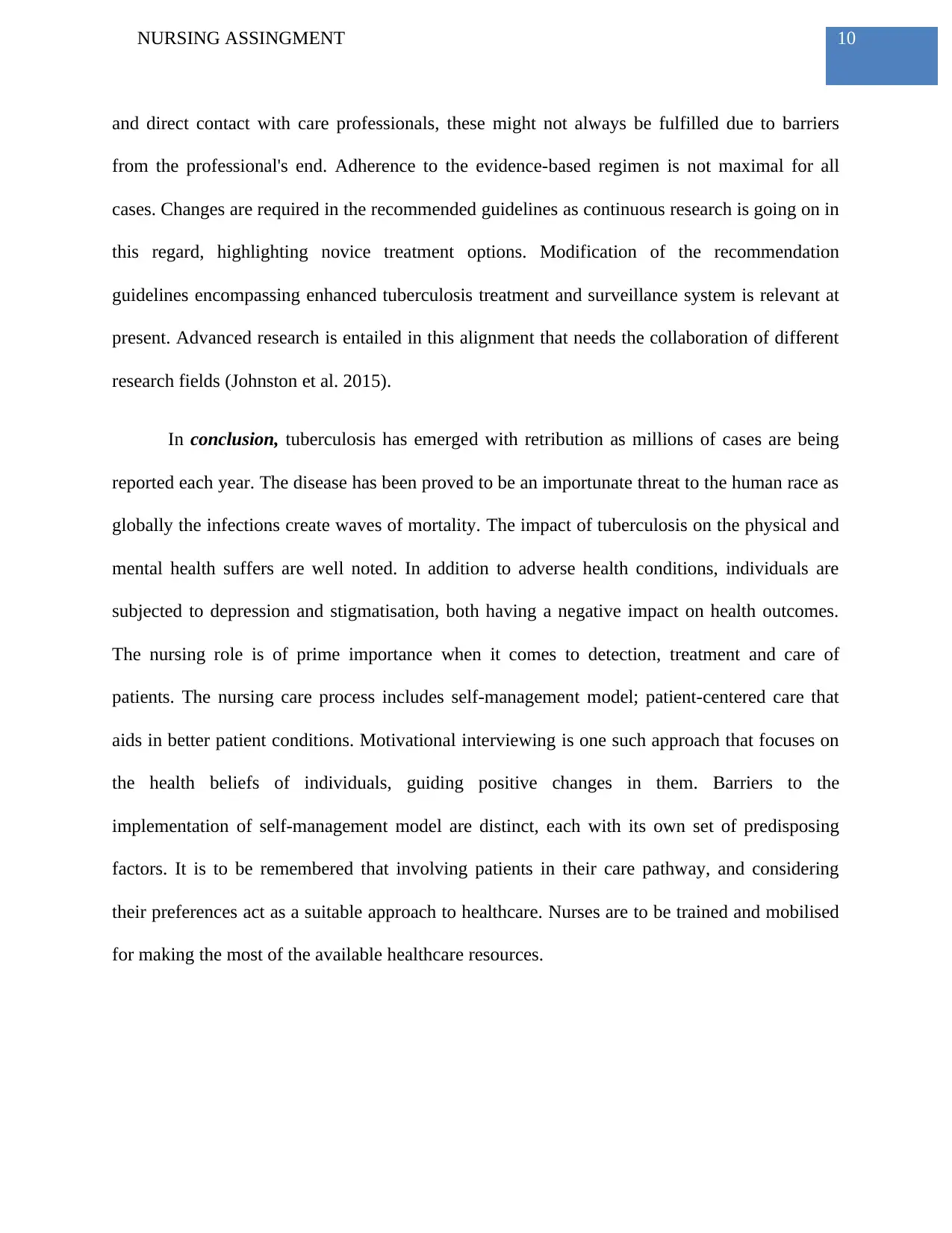
10NURSING ASSINGMENT
and direct contact with care professionals, these might not always be fulfilled due to barriers
from the professional's end. Adherence to the evidence-based regimen is not maximal for all
cases. Changes are required in the recommended guidelines as continuous research is going on in
this regard, highlighting novice treatment options. Modification of the recommendation
guidelines encompassing enhanced tuberculosis treatment and surveillance system is relevant at
present. Advanced research is entailed in this alignment that needs the collaboration of different
research fields (Johnston et al. 2015).
In conclusion, tuberculosis has emerged with retribution as millions of cases are being
reported each year. The disease has been proved to be an importunate threat to the human race as
globally the infections create waves of mortality. The impact of tuberculosis on the physical and
mental health suffers are well noted. In addition to adverse health conditions, individuals are
subjected to depression and stigmatisation, both having a negative impact on health outcomes.
The nursing role is of prime importance when it comes to detection, treatment and care of
patients. The nursing care process includes self-management model; patient-centered care that
aids in better patient conditions. Motivational interviewing is one such approach that focuses on
the health beliefs of individuals, guiding positive changes in them. Barriers to the
implementation of self-management model are distinct, each with its own set of predisposing
factors. It is to be remembered that involving patients in their care pathway, and considering
their preferences act as a suitable approach to healthcare. Nurses are to be trained and mobilised
for making the most of the available healthcare resources.
and direct contact with care professionals, these might not always be fulfilled due to barriers
from the professional's end. Adherence to the evidence-based regimen is not maximal for all
cases. Changes are required in the recommended guidelines as continuous research is going on in
this regard, highlighting novice treatment options. Modification of the recommendation
guidelines encompassing enhanced tuberculosis treatment and surveillance system is relevant at
present. Advanced research is entailed in this alignment that needs the collaboration of different
research fields (Johnston et al. 2015).
In conclusion, tuberculosis has emerged with retribution as millions of cases are being
reported each year. The disease has been proved to be an importunate threat to the human race as
globally the infections create waves of mortality. The impact of tuberculosis on the physical and
mental health suffers are well noted. In addition to adverse health conditions, individuals are
subjected to depression and stigmatisation, both having a negative impact on health outcomes.
The nursing role is of prime importance when it comes to detection, treatment and care of
patients. The nursing care process includes self-management model; patient-centered care that
aids in better patient conditions. Motivational interviewing is one such approach that focuses on
the health beliefs of individuals, guiding positive changes in them. Barriers to the
implementation of self-management model are distinct, each with its own set of predisposing
factors. It is to be remembered that involving patients in their care pathway, and considering
their preferences act as a suitable approach to healthcare. Nurses are to be trained and mobilised
for making the most of the available healthcare resources.
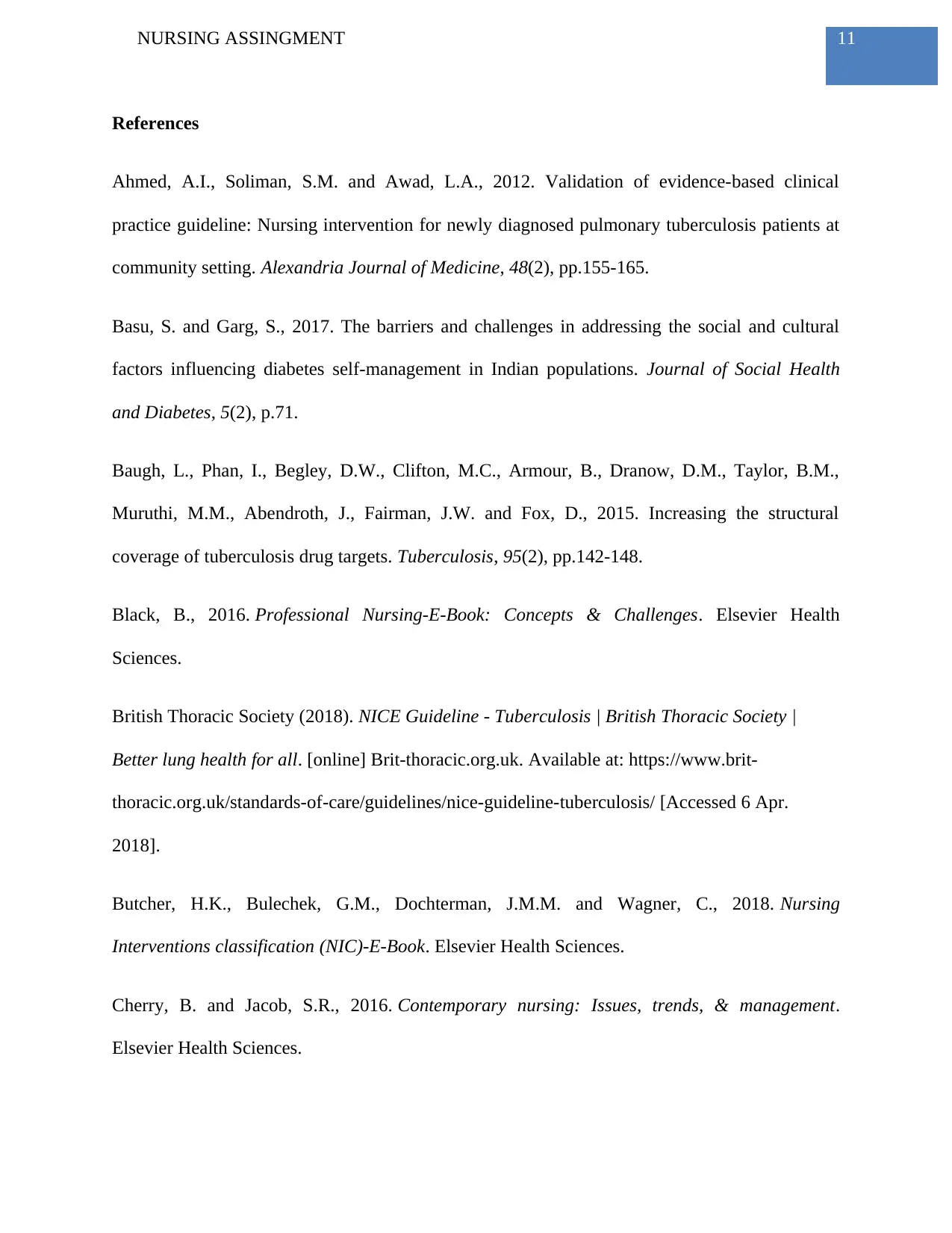
11NURSING ASSINGMENT
References
Ahmed, A.I., Soliman, S.M. and Awad, L.A., 2012. Validation of evidence-based clinical
practice guideline: Nursing intervention for newly diagnosed pulmonary tuberculosis patients at
community setting. Alexandria Journal of Medicine, 48(2), pp.155-165.
Basu, S. and Garg, S., 2017. The barriers and challenges in addressing the social and cultural
factors influencing diabetes self-management in Indian populations. Journal of Social Health
and Diabetes, 5(2), p.71.
Baugh, L., Phan, I., Begley, D.W., Clifton, M.C., Armour, B., Dranow, D.M., Taylor, B.M.,
Muruthi, M.M., Abendroth, J., Fairman, J.W. and Fox, D., 2015. Increasing the structural
coverage of tuberculosis drug targets. Tuberculosis, 95(2), pp.142-148.
Black, B., 2016. Professional Nursing-E-Book: Concepts & Challenges. Elsevier Health
Sciences.
British Thoracic Society (2018). NICE Guideline - Tuberculosis | British Thoracic Society |
Better lung health for all. [online] Brit-thoracic.org.uk. Available at: https://www.brit-
thoracic.org.uk/standards-of-care/guidelines/nice-guideline-tuberculosis/ [Accessed 6 Apr.
2018].
Butcher, H.K., Bulechek, G.M., Dochterman, J.M.M. and Wagner, C., 2018. Nursing
Interventions classification (NIC)-E-Book. Elsevier Health Sciences.
Cherry, B. and Jacob, S.R., 2016. Contemporary nursing: Issues, trends, & management.
Elsevier Health Sciences.
References
Ahmed, A.I., Soliman, S.M. and Awad, L.A., 2012. Validation of evidence-based clinical
practice guideline: Nursing intervention for newly diagnosed pulmonary tuberculosis patients at
community setting. Alexandria Journal of Medicine, 48(2), pp.155-165.
Basu, S. and Garg, S., 2017. The barriers and challenges in addressing the social and cultural
factors influencing diabetes self-management in Indian populations. Journal of Social Health
and Diabetes, 5(2), p.71.
Baugh, L., Phan, I., Begley, D.W., Clifton, M.C., Armour, B., Dranow, D.M., Taylor, B.M.,
Muruthi, M.M., Abendroth, J., Fairman, J.W. and Fox, D., 2015. Increasing the structural
coverage of tuberculosis drug targets. Tuberculosis, 95(2), pp.142-148.
Black, B., 2016. Professional Nursing-E-Book: Concepts & Challenges. Elsevier Health
Sciences.
British Thoracic Society (2018). NICE Guideline - Tuberculosis | British Thoracic Society |
Better lung health for all. [online] Brit-thoracic.org.uk. Available at: https://www.brit-
thoracic.org.uk/standards-of-care/guidelines/nice-guideline-tuberculosis/ [Accessed 6 Apr.
2018].
Butcher, H.K., Bulechek, G.M., Dochterman, J.M.M. and Wagner, C., 2018. Nursing
Interventions classification (NIC)-E-Book. Elsevier Health Sciences.
Cherry, B. and Jacob, S.R., 2016. Contemporary nursing: Issues, trends, & management.
Elsevier Health Sciences.
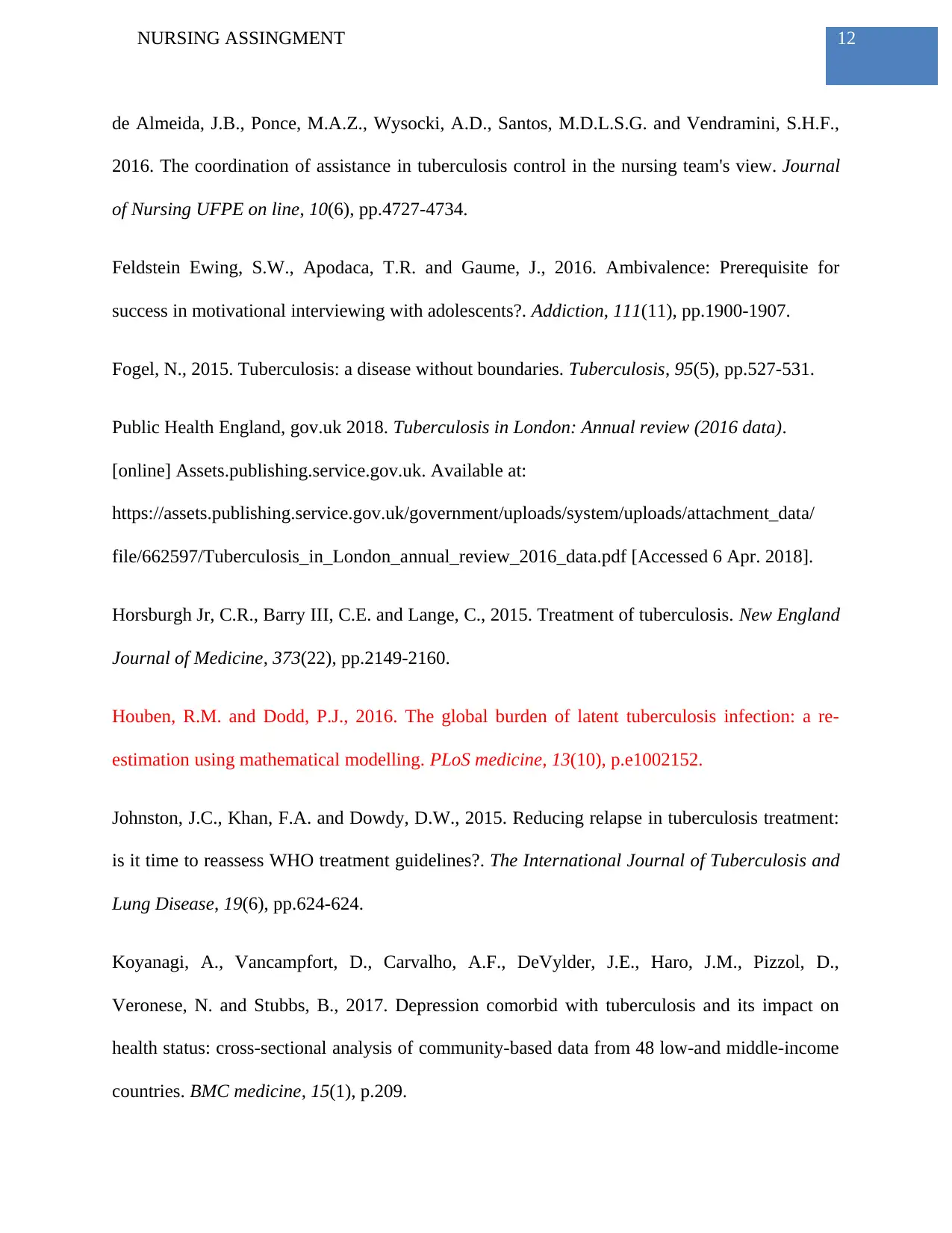
12NURSING ASSINGMENT
de Almeida, J.B., Ponce, M.A.Z., Wysocki, A.D., Santos, M.D.L.S.G. and Vendramini, S.H.F.,
2016. The coordination of assistance in tuberculosis control in the nursing team's view. Journal
of Nursing UFPE on line, 10(6), pp.4727-4734.
Feldstein Ewing, S.W., Apodaca, T.R. and Gaume, J., 2016. Ambivalence: Prerequisite for
success in motivational interviewing with adolescents?. Addiction, 111(11), pp.1900-1907.
Fogel, N., 2015. Tuberculosis: a disease without boundaries. Tuberculosis, 95(5), pp.527-531.
Public Health England, gov.uk 2018. Tuberculosis in London: Annual review (2016 data).
[online] Assets.publishing.service.gov.uk. Available at:
https://assets.publishing.service.gov.uk/government/uploads/system/uploads/attachment_data/
file/662597/Tuberculosis_in_London_annual_review_2016_data.pdf [Accessed 6 Apr. 2018].
Horsburgh Jr, C.R., Barry III, C.E. and Lange, C., 2015. Treatment of tuberculosis. New England
Journal of Medicine, 373(22), pp.2149-2160.
Houben, R.M. and Dodd, P.J., 2016. The global burden of latent tuberculosis infection: a re-
estimation using mathematical modelling. PLoS medicine, 13(10), p.e1002152.
Johnston, J.C., Khan, F.A. and Dowdy, D.W., 2015. Reducing relapse in tuberculosis treatment:
is it time to reassess WHO treatment guidelines?. The International Journal of Tuberculosis and
Lung Disease, 19(6), pp.624-624.
Koyanagi, A., Vancampfort, D., Carvalho, A.F., DeVylder, J.E., Haro, J.M., Pizzol, D.,
Veronese, N. and Stubbs, B., 2017. Depression comorbid with tuberculosis and its impact on
health status: cross-sectional analysis of community-based data from 48 low-and middle-income
countries. BMC medicine, 15(1), p.209.
de Almeida, J.B., Ponce, M.A.Z., Wysocki, A.D., Santos, M.D.L.S.G. and Vendramini, S.H.F.,
2016. The coordination of assistance in tuberculosis control in the nursing team's view. Journal
of Nursing UFPE on line, 10(6), pp.4727-4734.
Feldstein Ewing, S.W., Apodaca, T.R. and Gaume, J., 2016. Ambivalence: Prerequisite for
success in motivational interviewing with adolescents?. Addiction, 111(11), pp.1900-1907.
Fogel, N., 2015. Tuberculosis: a disease without boundaries. Tuberculosis, 95(5), pp.527-531.
Public Health England, gov.uk 2018. Tuberculosis in London: Annual review (2016 data).
[online] Assets.publishing.service.gov.uk. Available at:
https://assets.publishing.service.gov.uk/government/uploads/system/uploads/attachment_data/
file/662597/Tuberculosis_in_London_annual_review_2016_data.pdf [Accessed 6 Apr. 2018].
Horsburgh Jr, C.R., Barry III, C.E. and Lange, C., 2015. Treatment of tuberculosis. New England
Journal of Medicine, 373(22), pp.2149-2160.
Houben, R.M. and Dodd, P.J., 2016. The global burden of latent tuberculosis infection: a re-
estimation using mathematical modelling. PLoS medicine, 13(10), p.e1002152.
Johnston, J.C., Khan, F.A. and Dowdy, D.W., 2015. Reducing relapse in tuberculosis treatment:
is it time to reassess WHO treatment guidelines?. The International Journal of Tuberculosis and
Lung Disease, 19(6), pp.624-624.
Koyanagi, A., Vancampfort, D., Carvalho, A.F., DeVylder, J.E., Haro, J.M., Pizzol, D.,
Veronese, N. and Stubbs, B., 2017. Depression comorbid with tuberculosis and its impact on
health status: cross-sectional analysis of community-based data from 48 low-and middle-income
countries. BMC medicine, 15(1), p.209.
Paraphrase This Document
Need a fresh take? Get an instant paraphrase of this document with our AI Paraphraser
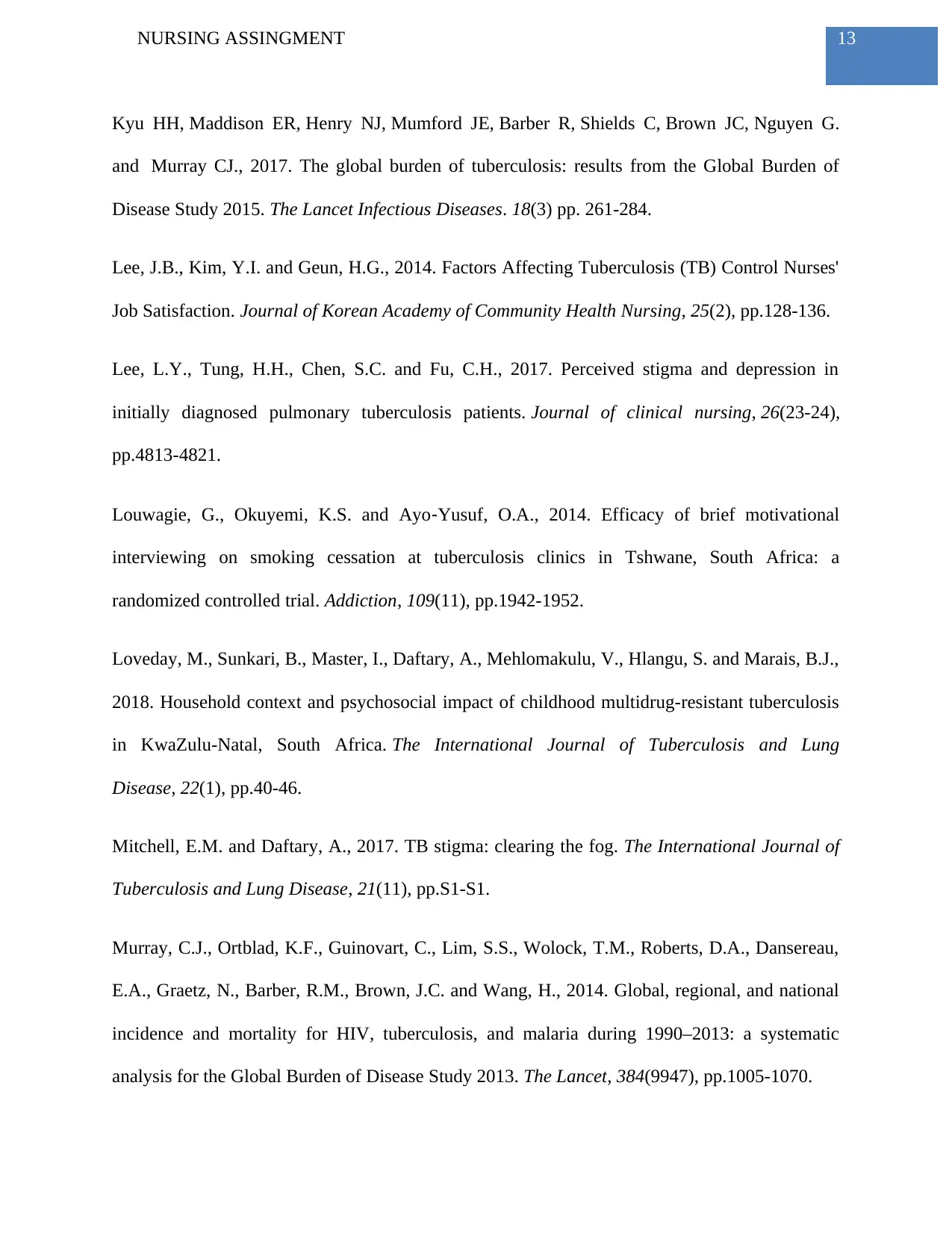
13NURSING ASSINGMENT
Kyu HH, Maddison ER, Henry NJ, Mumford JE, Barber R, Shields C, Brown JC, Nguyen G.
and Murray CJ., 2017. The global burden of tuberculosis: results from the Global Burden of
Disease Study 2015. The Lancet Infectious Diseases. 18(3) pp. 261-284.
Lee, J.B., Kim, Y.I. and Geun, H.G., 2014. Factors Affecting Tuberculosis (TB) Control Nurses'
Job Satisfaction. Journal of Korean Academy of Community Health Nursing, 25(2), pp.128-136.
Lee, L.Y., Tung, H.H., Chen, S.C. and Fu, C.H., 2017. Perceived stigma and depression in
initially diagnosed pulmonary tuberculosis patients. Journal of clinical nursing, 26(23-24),
pp.4813-4821.
Louwagie, G., Okuyemi, K.S. and Ayo‐Yusuf, O.A., 2014. Efficacy of brief motivational
interviewing on smoking cessation at tuberculosis clinics in Tshwane, South Africa: a
randomized controlled trial. Addiction, 109(11), pp.1942-1952.
Loveday, M., Sunkari, B., Master, I., Daftary, A., Mehlomakulu, V., Hlangu, S. and Marais, B.J.,
2018. Household context and psychosocial impact of childhood multidrug-resistant tuberculosis
in KwaZulu-Natal, South Africa. The International Journal of Tuberculosis and Lung
Disease, 22(1), pp.40-46.
Mitchell, E.M. and Daftary, A., 2017. TB stigma: clearing the fog. The International Journal of
Tuberculosis and Lung Disease, 21(11), pp.S1-S1.
Murray, C.J., Ortblad, K.F., Guinovart, C., Lim, S.S., Wolock, T.M., Roberts, D.A., Dansereau,
E.A., Graetz, N., Barber, R.M., Brown, J.C. and Wang, H., 2014. Global, regional, and national
incidence and mortality for HIV, tuberculosis, and malaria during 1990–2013: a systematic
analysis for the Global Burden of Disease Study 2013. The Lancet, 384(9947), pp.1005-1070.
Kyu HH, Maddison ER, Henry NJ, Mumford JE, Barber R, Shields C, Brown JC, Nguyen G.
and Murray CJ., 2017. The global burden of tuberculosis: results from the Global Burden of
Disease Study 2015. The Lancet Infectious Diseases. 18(3) pp. 261-284.
Lee, J.B., Kim, Y.I. and Geun, H.G., 2014. Factors Affecting Tuberculosis (TB) Control Nurses'
Job Satisfaction. Journal of Korean Academy of Community Health Nursing, 25(2), pp.128-136.
Lee, L.Y., Tung, H.H., Chen, S.C. and Fu, C.H., 2017. Perceived stigma and depression in
initially diagnosed pulmonary tuberculosis patients. Journal of clinical nursing, 26(23-24),
pp.4813-4821.
Louwagie, G., Okuyemi, K.S. and Ayo‐Yusuf, O.A., 2014. Efficacy of brief motivational
interviewing on smoking cessation at tuberculosis clinics in Tshwane, South Africa: a
randomized controlled trial. Addiction, 109(11), pp.1942-1952.
Loveday, M., Sunkari, B., Master, I., Daftary, A., Mehlomakulu, V., Hlangu, S. and Marais, B.J.,
2018. Household context and psychosocial impact of childhood multidrug-resistant tuberculosis
in KwaZulu-Natal, South Africa. The International Journal of Tuberculosis and Lung
Disease, 22(1), pp.40-46.
Mitchell, E.M. and Daftary, A., 2017. TB stigma: clearing the fog. The International Journal of
Tuberculosis and Lung Disease, 21(11), pp.S1-S1.
Murray, C.J., Ortblad, K.F., Guinovart, C., Lim, S.S., Wolock, T.M., Roberts, D.A., Dansereau,
E.A., Graetz, N., Barber, R.M., Brown, J.C. and Wang, H., 2014. Global, regional, and national
incidence and mortality for HIV, tuberculosis, and malaria during 1990–2013: a systematic
analysis for the Global Burden of Disease Study 2013. The Lancet, 384(9947), pp.1005-1070.
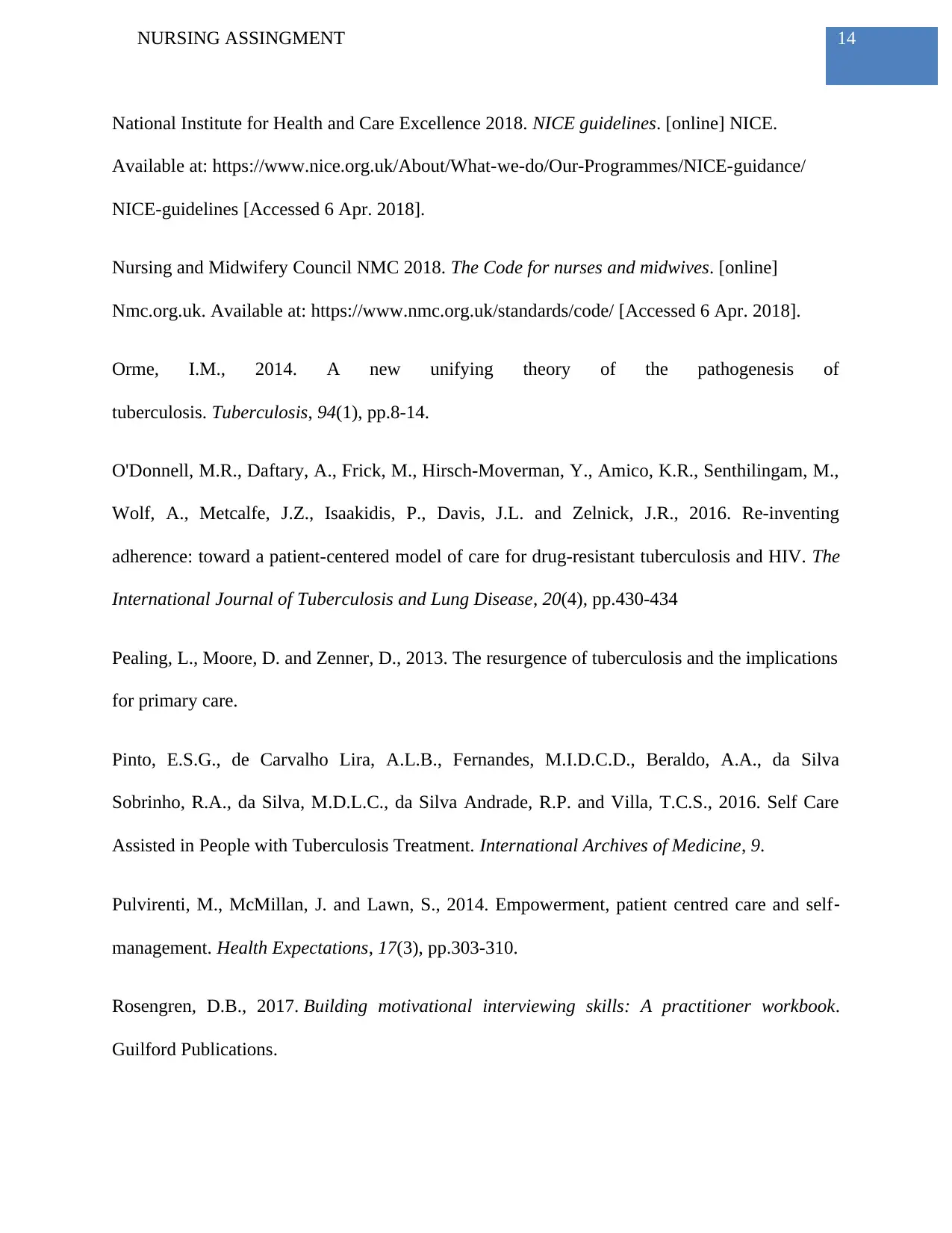
14NURSING ASSINGMENT
National Institute for Health and Care Excellence 2018. NICE guidelines. [online] NICE.
Available at: https://www.nice.org.uk/About/What-we-do/Our-Programmes/NICE-guidance/
NICE-guidelines [Accessed 6 Apr. 2018].
Nursing and Midwifery Council NMC 2018. The Code for nurses and midwives. [online]
Nmc.org.uk. Available at: https://www.nmc.org.uk/standards/code/ [Accessed 6 Apr. 2018].
Orme, I.M., 2014. A new unifying theory of the pathogenesis of
tuberculosis. Tuberculosis, 94(1), pp.8-14.
O'Donnell, M.R., Daftary, A., Frick, M., Hirsch-Moverman, Y., Amico, K.R., Senthilingam, M.,
Wolf, A., Metcalfe, J.Z., Isaakidis, P., Davis, J.L. and Zelnick, J.R., 2016. Re-inventing
adherence: toward a patient-centered model of care for drug-resistant tuberculosis and HIV. The
International Journal of Tuberculosis and Lung Disease, 20(4), pp.430-434
Pealing, L., Moore, D. and Zenner, D., 2013. The resurgence of tuberculosis and the implications
for primary care.
Pinto, E.S.G., de Carvalho Lira, A.L.B., Fernandes, M.I.D.C.D., Beraldo, A.A., da Silva
Sobrinho, R.A., da Silva, M.D.L.C., da Silva Andrade, R.P. and Villa, T.C.S., 2016. Self Care
Assisted in People with Tuberculosis Treatment. International Archives of Medicine, 9.
Pulvirenti, M., McMillan, J. and Lawn, S., 2014. Empowerment, patient centred care and self‐
management. Health Expectations, 17(3), pp.303-310.
Rosengren, D.B., 2017. Building motivational interviewing skills: A practitioner workbook.
Guilford Publications.
National Institute for Health and Care Excellence 2018. NICE guidelines. [online] NICE.
Available at: https://www.nice.org.uk/About/What-we-do/Our-Programmes/NICE-guidance/
NICE-guidelines [Accessed 6 Apr. 2018].
Nursing and Midwifery Council NMC 2018. The Code for nurses and midwives. [online]
Nmc.org.uk. Available at: https://www.nmc.org.uk/standards/code/ [Accessed 6 Apr. 2018].
Orme, I.M., 2014. A new unifying theory of the pathogenesis of
tuberculosis. Tuberculosis, 94(1), pp.8-14.
O'Donnell, M.R., Daftary, A., Frick, M., Hirsch-Moverman, Y., Amico, K.R., Senthilingam, M.,
Wolf, A., Metcalfe, J.Z., Isaakidis, P., Davis, J.L. and Zelnick, J.R., 2016. Re-inventing
adherence: toward a patient-centered model of care for drug-resistant tuberculosis and HIV. The
International Journal of Tuberculosis and Lung Disease, 20(4), pp.430-434
Pealing, L., Moore, D. and Zenner, D., 2013. The resurgence of tuberculosis and the implications
for primary care.
Pinto, E.S.G., de Carvalho Lira, A.L.B., Fernandes, M.I.D.C.D., Beraldo, A.A., da Silva
Sobrinho, R.A., da Silva, M.D.L.C., da Silva Andrade, R.P. and Villa, T.C.S., 2016. Self Care
Assisted in People with Tuberculosis Treatment. International Archives of Medicine, 9.
Pulvirenti, M., McMillan, J. and Lawn, S., 2014. Empowerment, patient centred care and self‐
management. Health Expectations, 17(3), pp.303-310.
Rosengren, D.B., 2017. Building motivational interviewing skills: A practitioner workbook.
Guilford Publications.
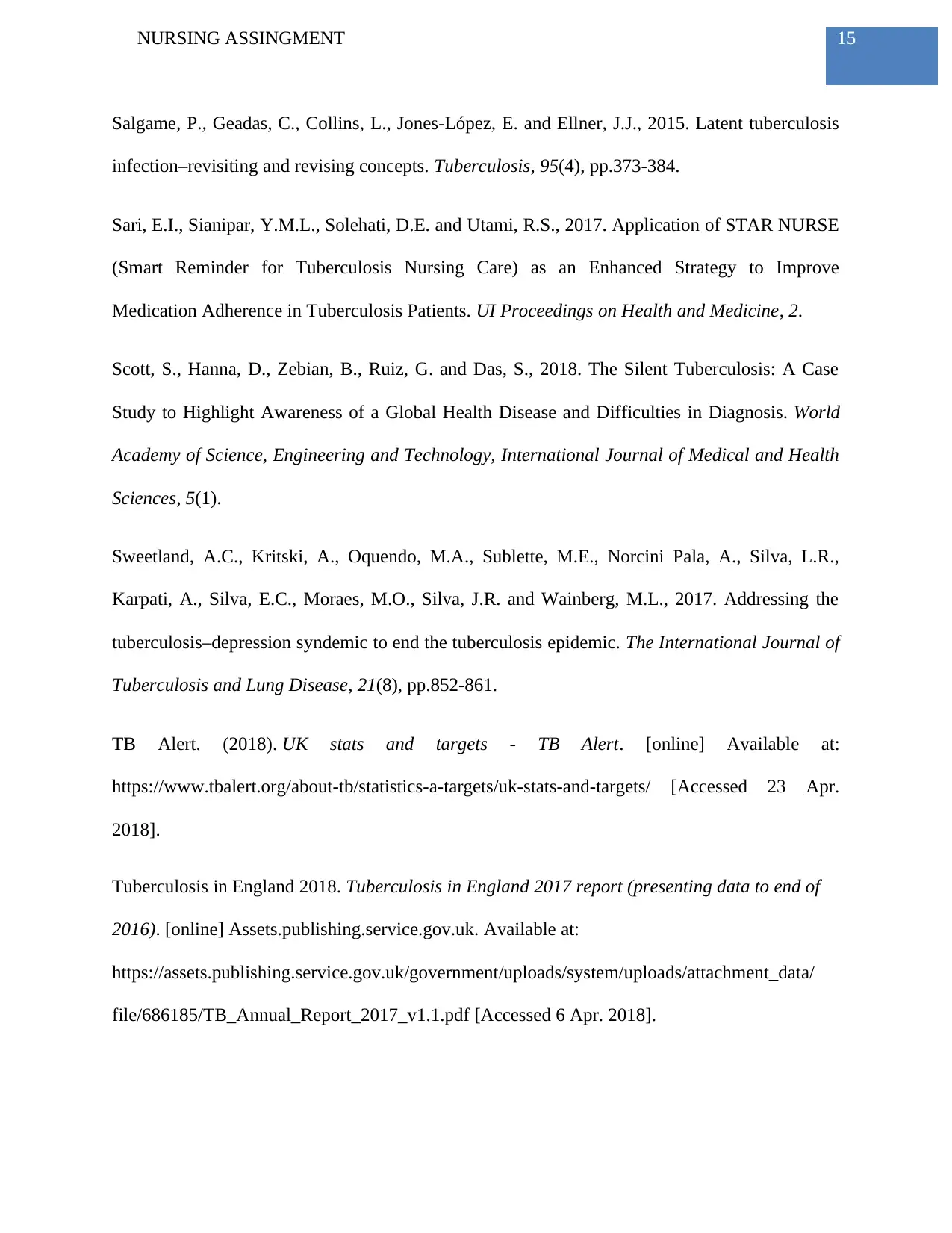
15NURSING ASSINGMENT
Salgame, P., Geadas, C., Collins, L., Jones-López, E. and Ellner, J.J., 2015. Latent tuberculosis
infection–revisiting and revising concepts. Tuberculosis, 95(4), pp.373-384.
Sari, E.I., Sianipar, Y.M.L., Solehati, D.E. and Utami, R.S., 2017. Application of STAR NURSE
(Smart Reminder for Tuberculosis Nursing Care) as an Enhanced Strategy to Improve
Medication Adherence in Tuberculosis Patients. UI Proceedings on Health and Medicine, 2.
Scott, S., Hanna, D., Zebian, B., Ruiz, G. and Das, S., 2018. The Silent Tuberculosis: A Case
Study to Highlight Awareness of a Global Health Disease and Difficulties in Diagnosis. World
Academy of Science, Engineering and Technology, International Journal of Medical and Health
Sciences, 5(1).
Sweetland, A.C., Kritski, A., Oquendo, M.A., Sublette, M.E., Norcini Pala, A., Silva, L.R.,
Karpati, A., Silva, E.C., Moraes, M.O., Silva, J.R. and Wainberg, M.L., 2017. Addressing the
tuberculosis–depression syndemic to end the tuberculosis epidemic. The International Journal of
Tuberculosis and Lung Disease, 21(8), pp.852-861.
TB Alert. (2018). UK stats and targets - TB Alert. [online] Available at:
https://www.tbalert.org/about-tb/statistics-a-targets/uk-stats-and-targets/ [Accessed 23 Apr.
2018].
Tuberculosis in England 2018. Tuberculosis in England 2017 report (presenting data to end of
2016). [online] Assets.publishing.service.gov.uk. Available at:
https://assets.publishing.service.gov.uk/government/uploads/system/uploads/attachment_data/
file/686185/TB_Annual_Report_2017_v1.1.pdf [Accessed 6 Apr. 2018].
Salgame, P., Geadas, C., Collins, L., Jones-López, E. and Ellner, J.J., 2015. Latent tuberculosis
infection–revisiting and revising concepts. Tuberculosis, 95(4), pp.373-384.
Sari, E.I., Sianipar, Y.M.L., Solehati, D.E. and Utami, R.S., 2017. Application of STAR NURSE
(Smart Reminder for Tuberculosis Nursing Care) as an Enhanced Strategy to Improve
Medication Adherence in Tuberculosis Patients. UI Proceedings on Health and Medicine, 2.
Scott, S., Hanna, D., Zebian, B., Ruiz, G. and Das, S., 2018. The Silent Tuberculosis: A Case
Study to Highlight Awareness of a Global Health Disease and Difficulties in Diagnosis. World
Academy of Science, Engineering and Technology, International Journal of Medical and Health
Sciences, 5(1).
Sweetland, A.C., Kritski, A., Oquendo, M.A., Sublette, M.E., Norcini Pala, A., Silva, L.R.,
Karpati, A., Silva, E.C., Moraes, M.O., Silva, J.R. and Wainberg, M.L., 2017. Addressing the
tuberculosis–depression syndemic to end the tuberculosis epidemic. The International Journal of
Tuberculosis and Lung Disease, 21(8), pp.852-861.
TB Alert. (2018). UK stats and targets - TB Alert. [online] Available at:
https://www.tbalert.org/about-tb/statistics-a-targets/uk-stats-and-targets/ [Accessed 23 Apr.
2018].
Tuberculosis in England 2018. Tuberculosis in England 2017 report (presenting data to end of
2016). [online] Assets.publishing.service.gov.uk. Available at:
https://assets.publishing.service.gov.uk/government/uploads/system/uploads/attachment_data/
file/686185/TB_Annual_Report_2017_v1.1.pdf [Accessed 6 Apr. 2018].
Secure Best Marks with AI Grader
Need help grading? Try our AI Grader for instant feedback on your assignments.
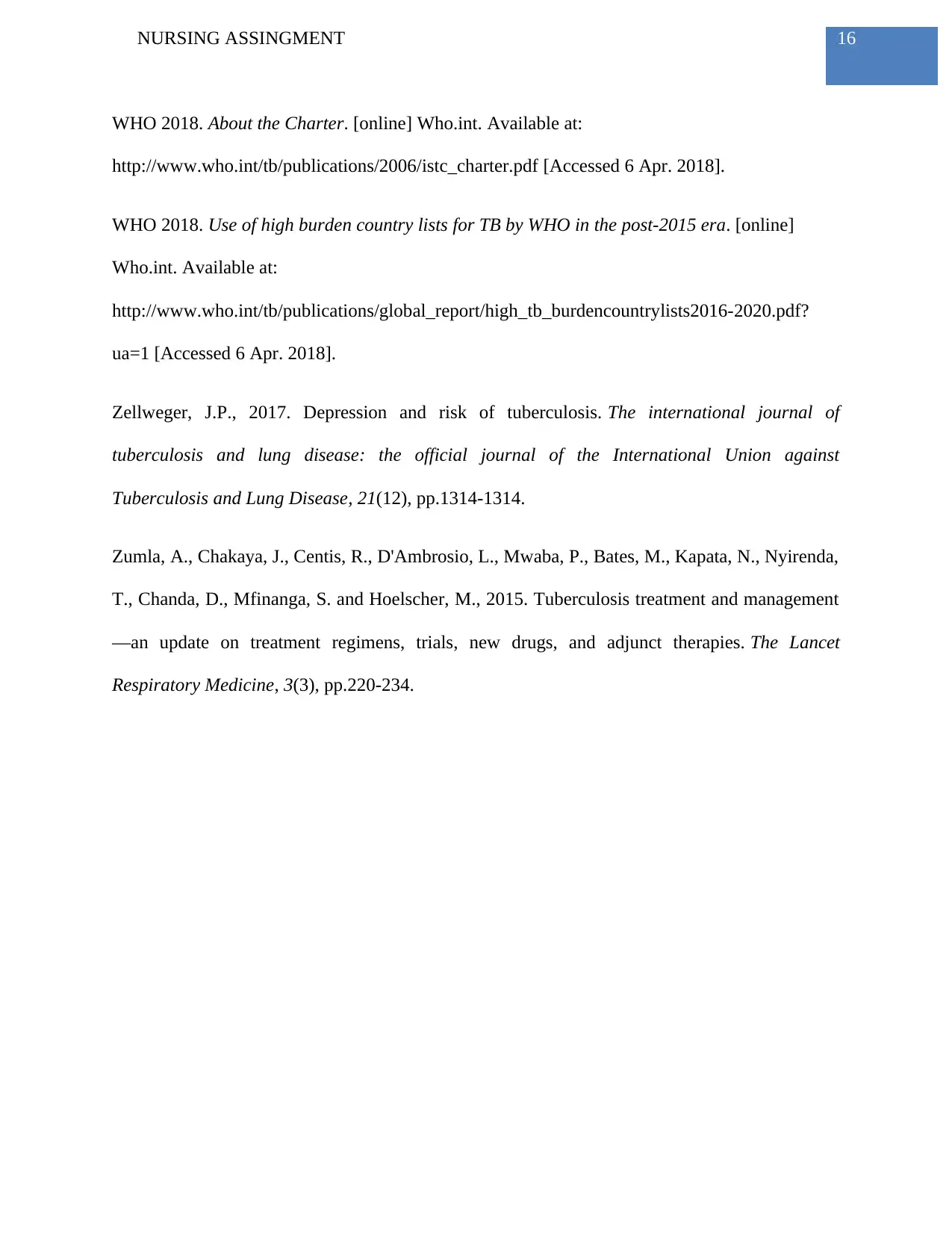
16NURSING ASSINGMENT
WHO 2018. About the Charter. [online] Who.int. Available at:
http://www.who.int/tb/publications/2006/istc_charter.pdf [Accessed 6 Apr. 2018].
WHO 2018. Use of high burden country lists for TB by WHO in the post-2015 era. [online]
Who.int. Available at:
http://www.who.int/tb/publications/global_report/high_tb_burdencountrylists2016-2020.pdf?
ua=1 [Accessed 6 Apr. 2018].
Zellweger, J.P., 2017. Depression and risk of tuberculosis. The international journal of
tuberculosis and lung disease: the official journal of the International Union against
Tuberculosis and Lung Disease, 21(12), pp.1314-1314.
Zumla, A., Chakaya, J., Centis, R., D'Ambrosio, L., Mwaba, P., Bates, M., Kapata, N., Nyirenda,
T., Chanda, D., Mfinanga, S. and Hoelscher, M., 2015. Tuberculosis treatment and management
—an update on treatment regimens, trials, new drugs, and adjunct therapies. The Lancet
Respiratory Medicine, 3(3), pp.220-234.
WHO 2018. About the Charter. [online] Who.int. Available at:
http://www.who.int/tb/publications/2006/istc_charter.pdf [Accessed 6 Apr. 2018].
WHO 2018. Use of high burden country lists for TB by WHO in the post-2015 era. [online]
Who.int. Available at:
http://www.who.int/tb/publications/global_report/high_tb_burdencountrylists2016-2020.pdf?
ua=1 [Accessed 6 Apr. 2018].
Zellweger, J.P., 2017. Depression and risk of tuberculosis. The international journal of
tuberculosis and lung disease: the official journal of the International Union against
Tuberculosis and Lung Disease, 21(12), pp.1314-1314.
Zumla, A., Chakaya, J., Centis, R., D'Ambrosio, L., Mwaba, P., Bates, M., Kapata, N., Nyirenda,
T., Chanda, D., Mfinanga, S. and Hoelscher, M., 2015. Tuberculosis treatment and management
—an update on treatment regimens, trials, new drugs, and adjunct therapies. The Lancet
Respiratory Medicine, 3(3), pp.220-234.
1 out of 17
Related Documents
Your All-in-One AI-Powered Toolkit for Academic Success.
+13062052269
info@desklib.com
Available 24*7 on WhatsApp / Email
![[object Object]](/_next/static/media/star-bottom.7253800d.svg)
Unlock your academic potential
© 2024 | Zucol Services PVT LTD | All rights reserved.





